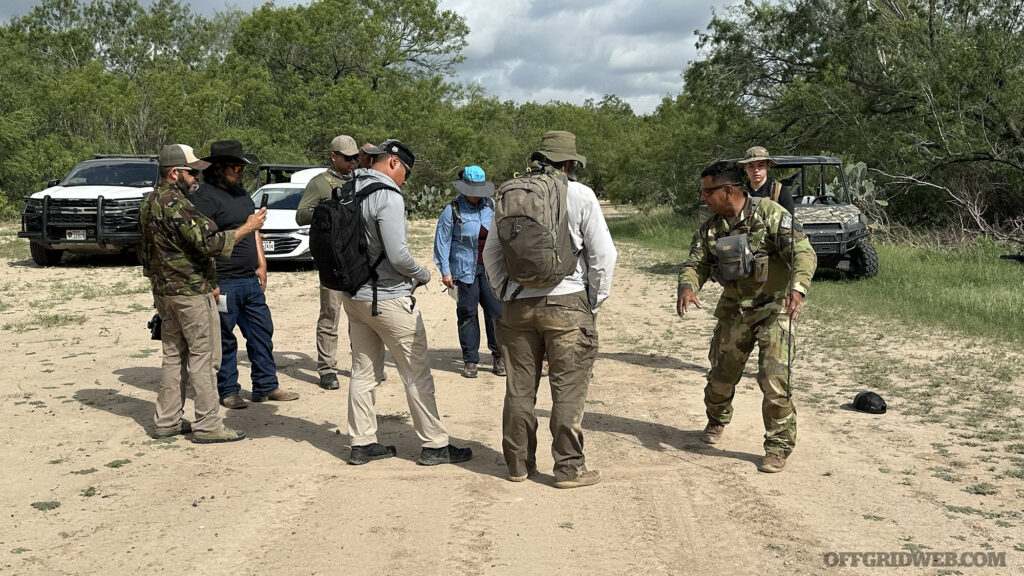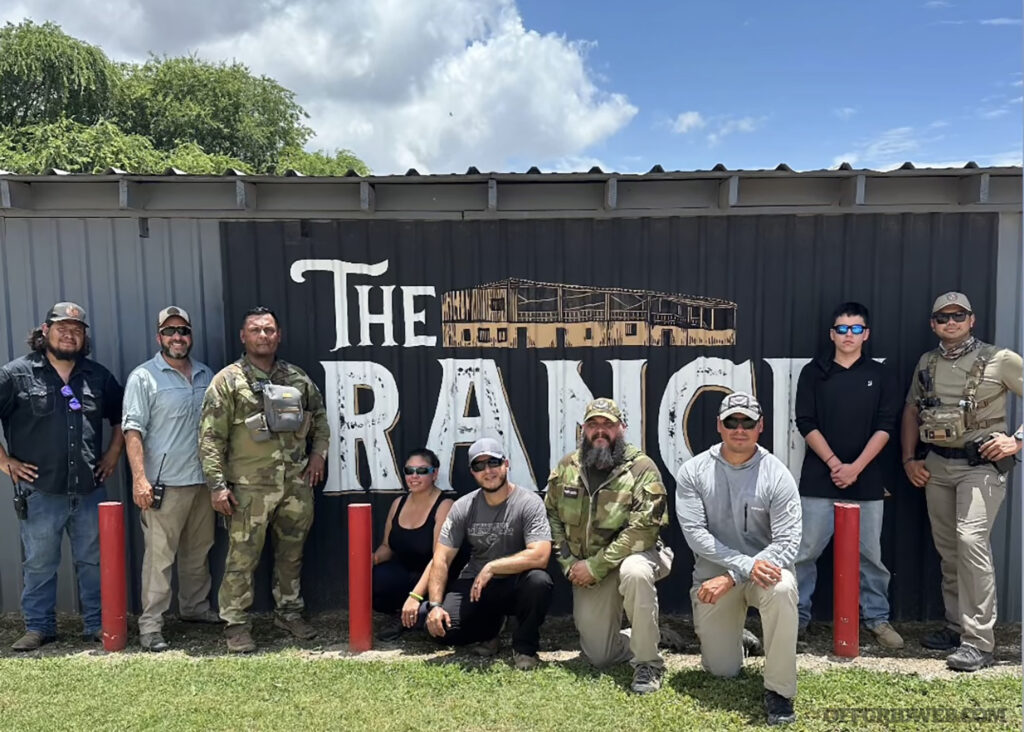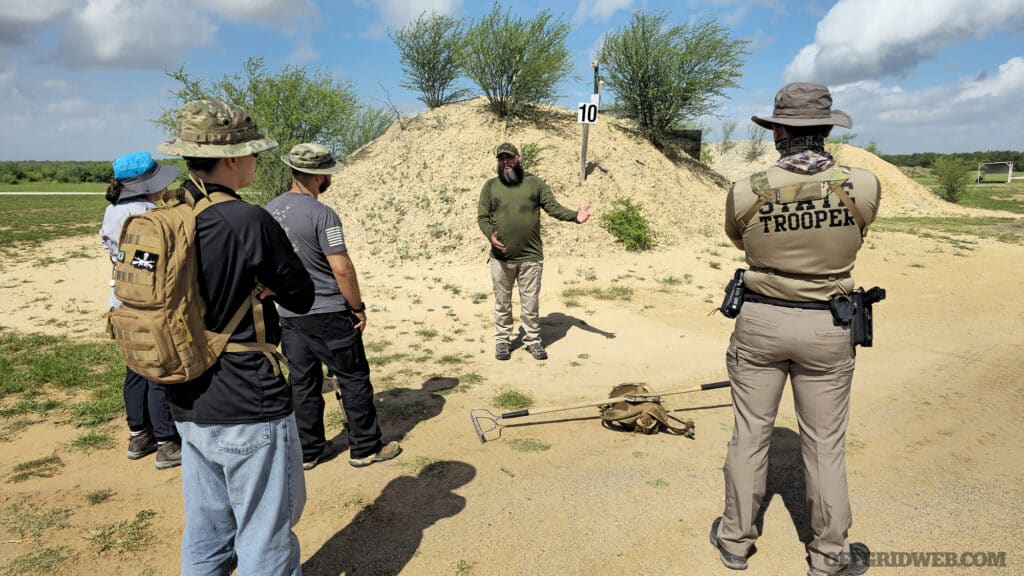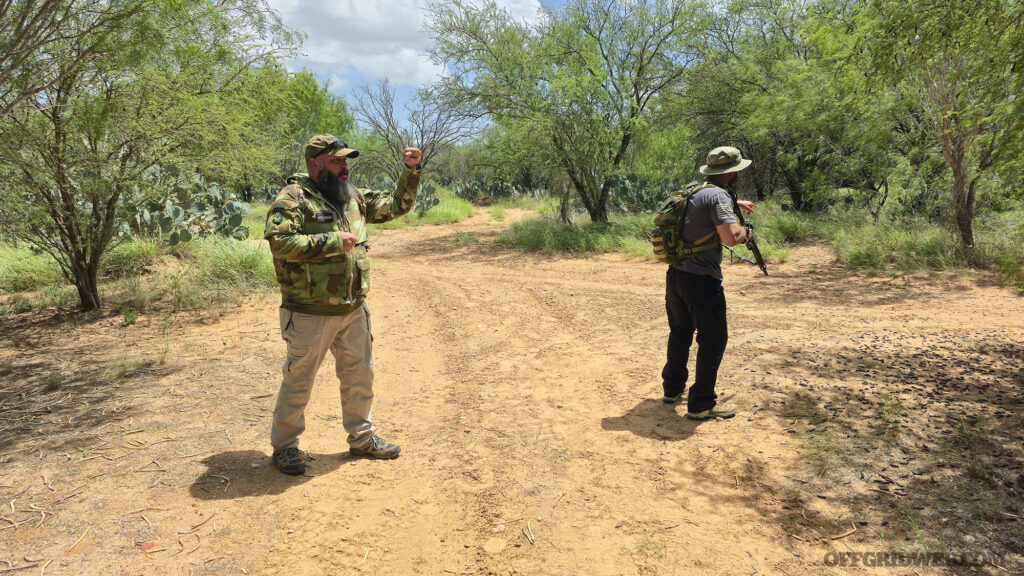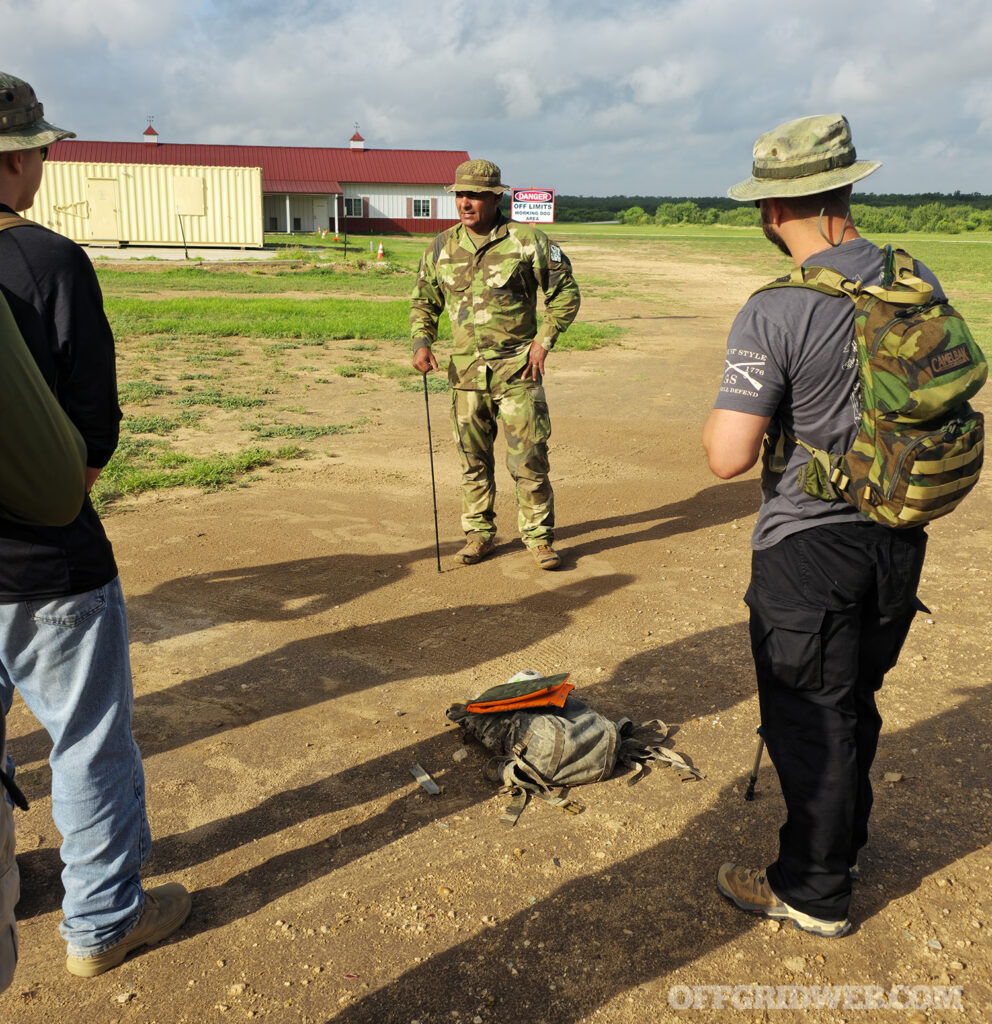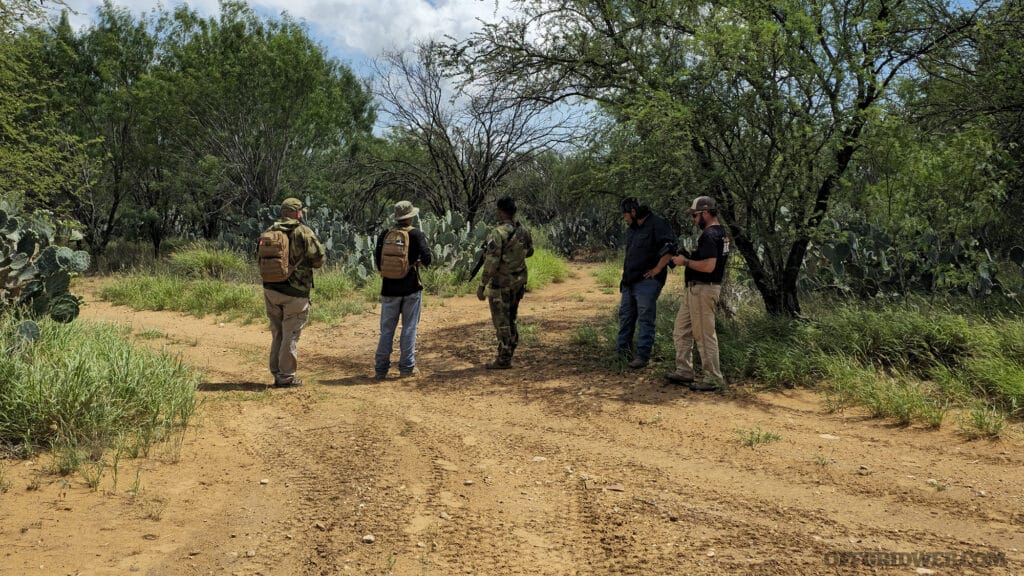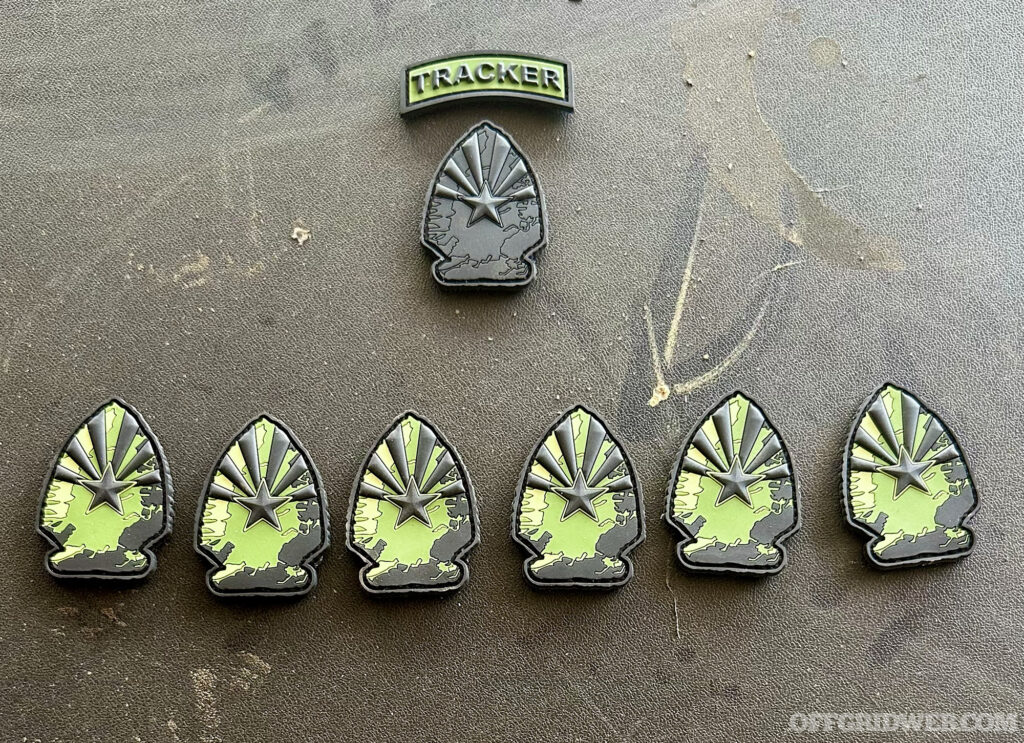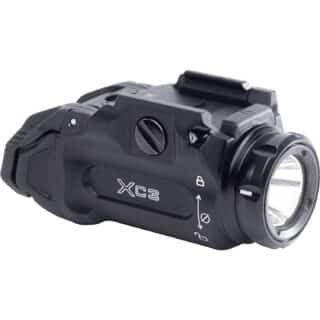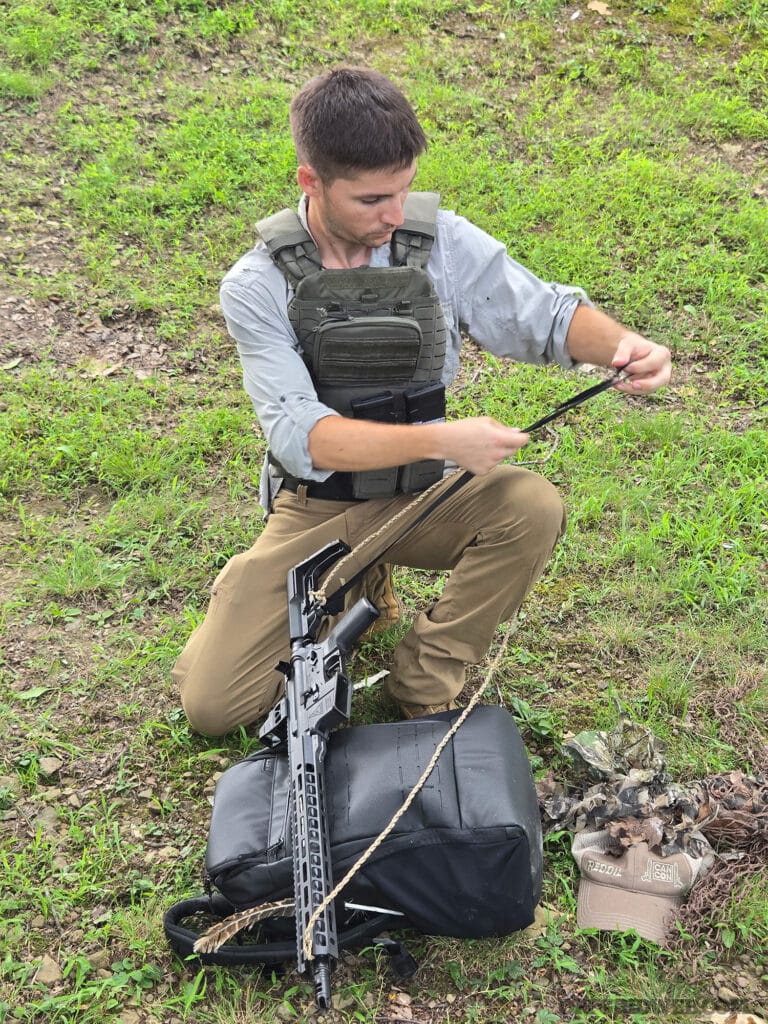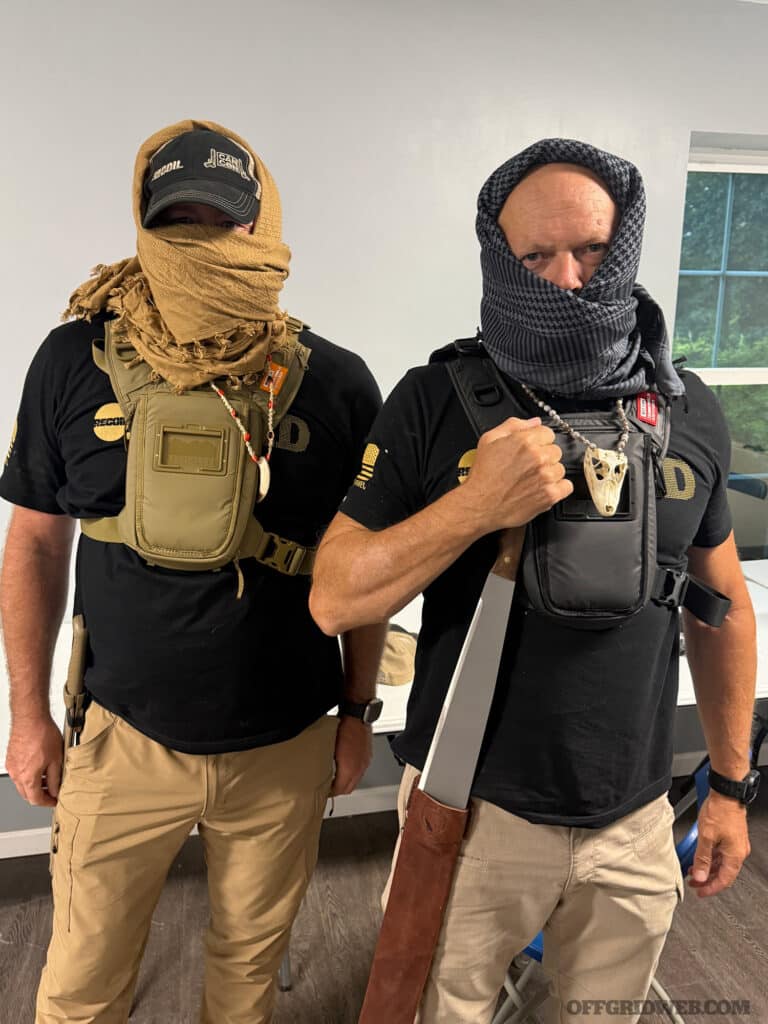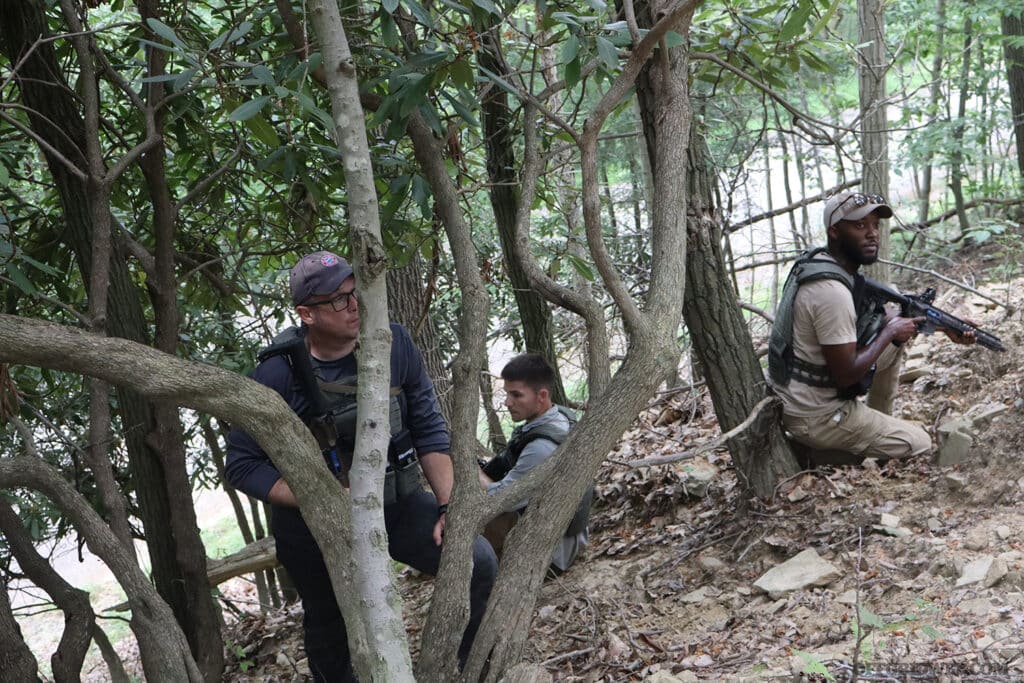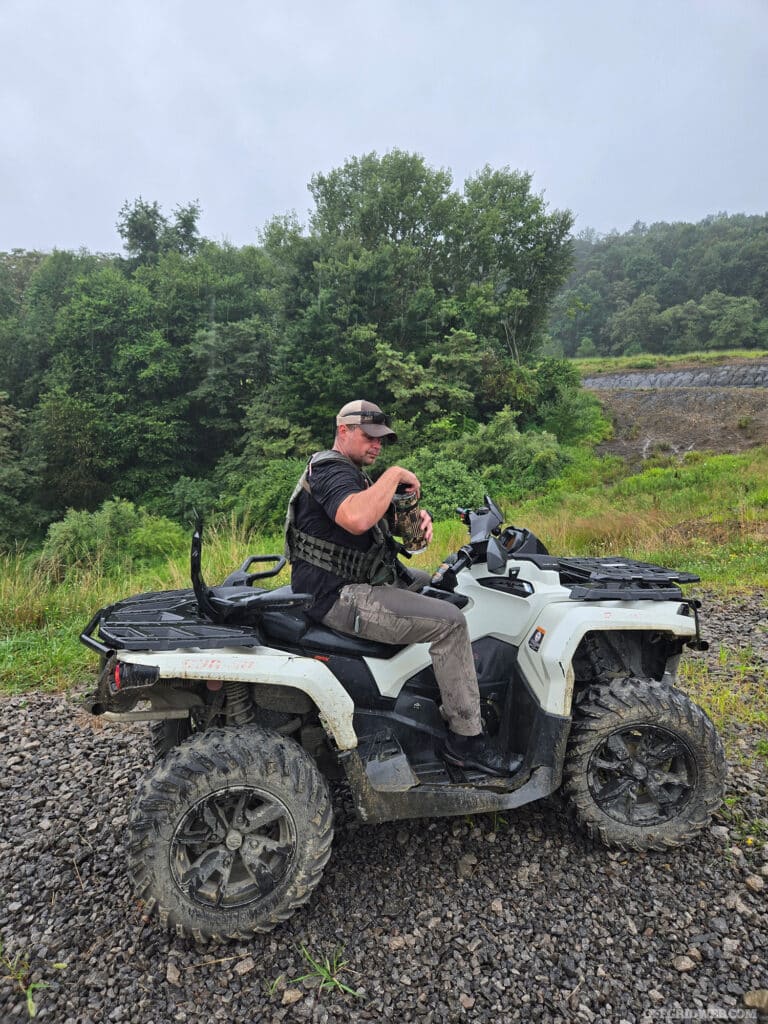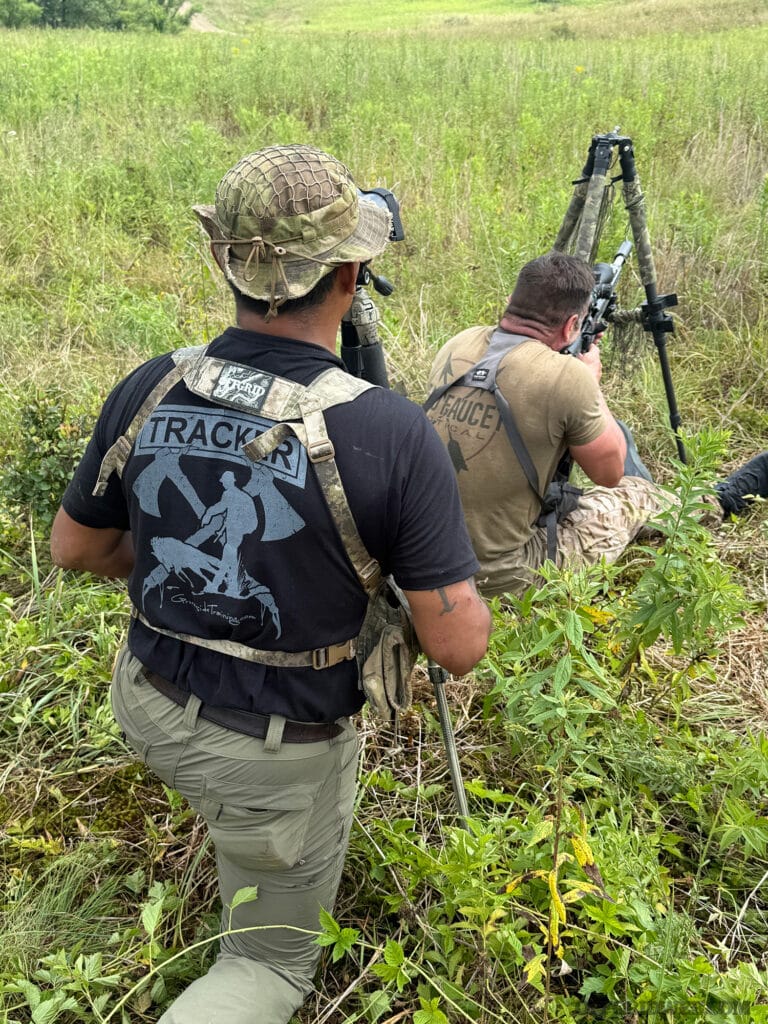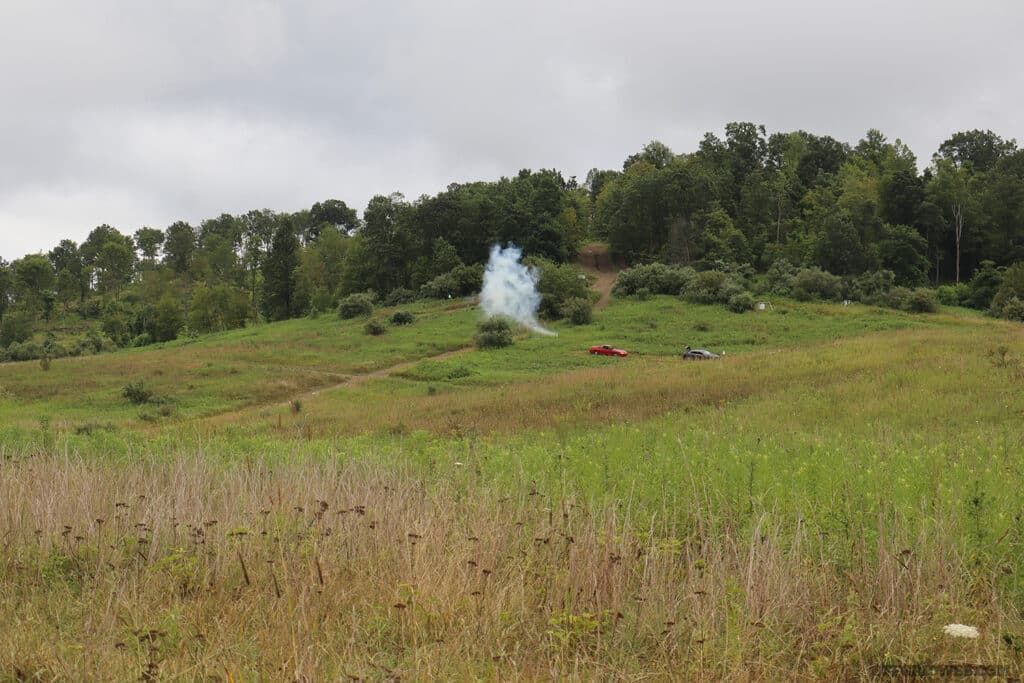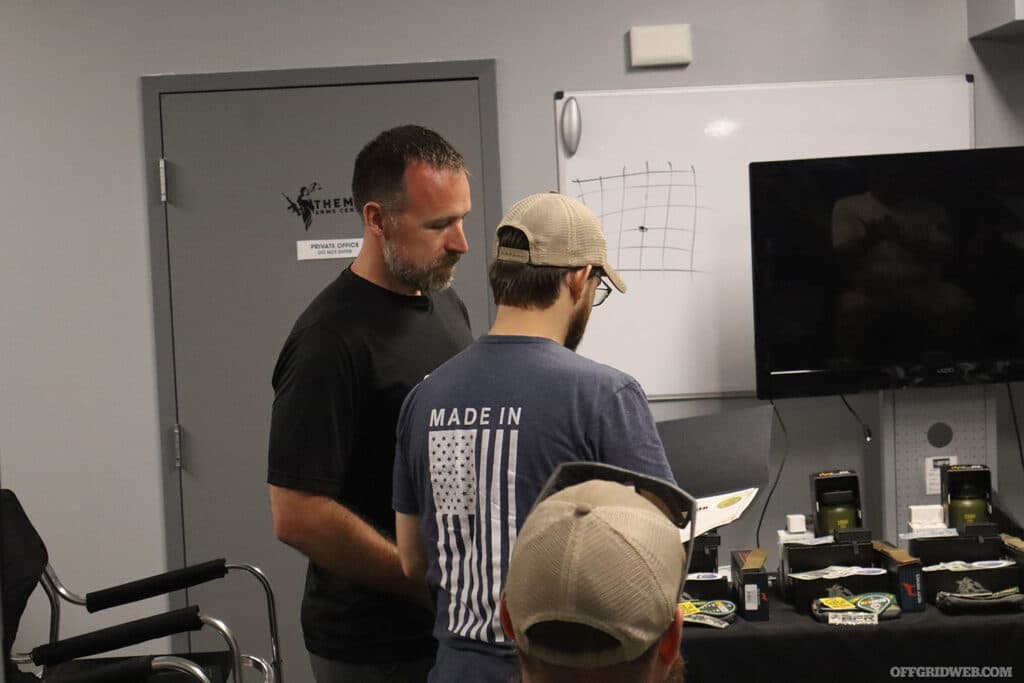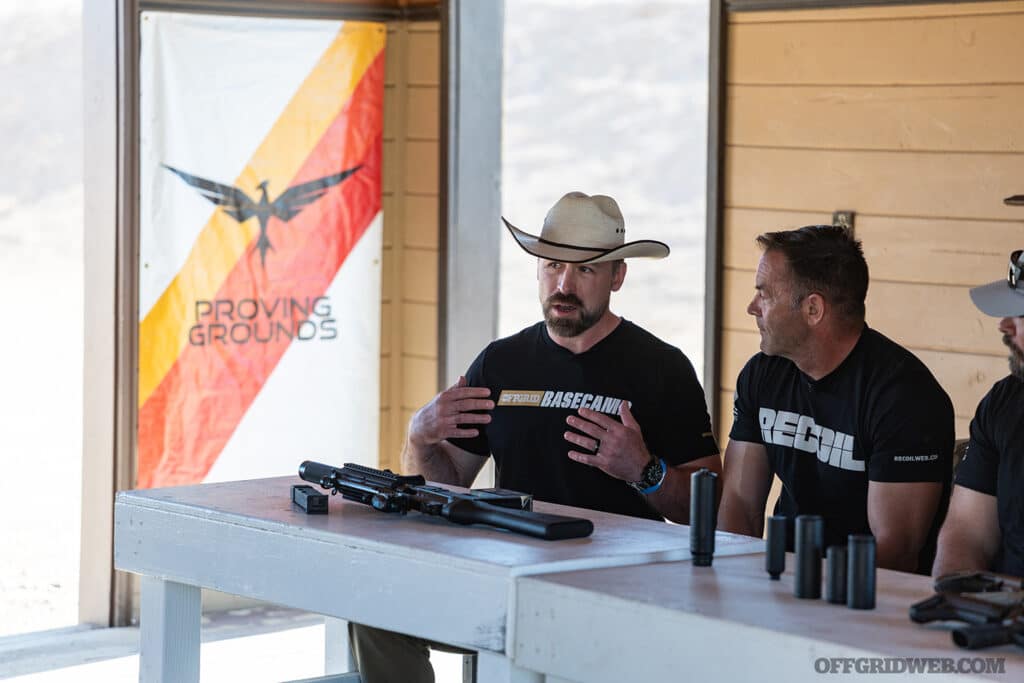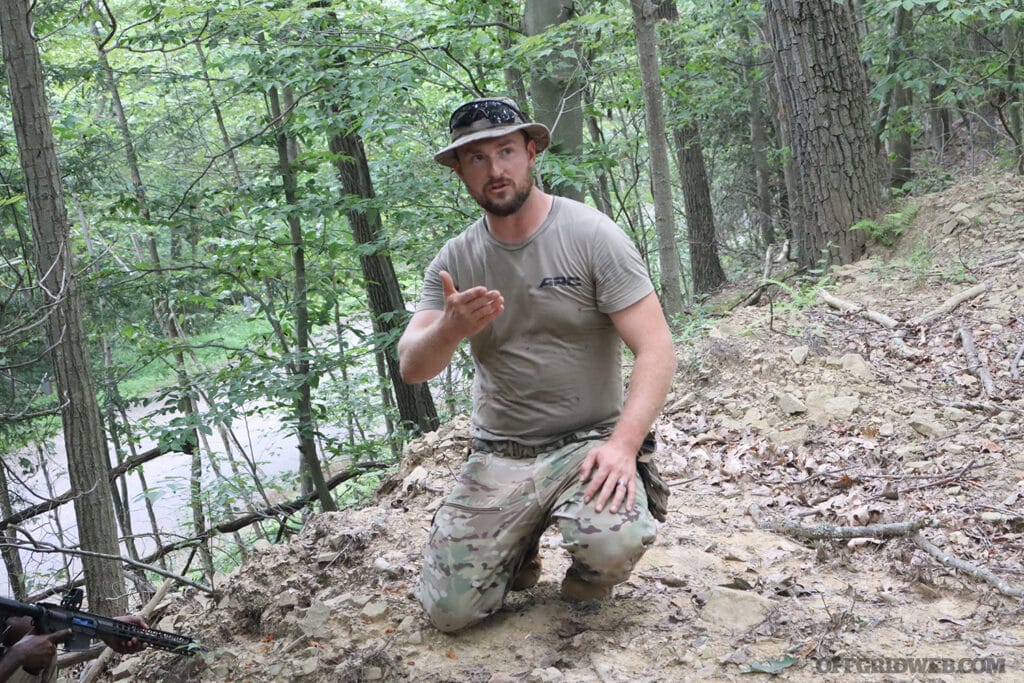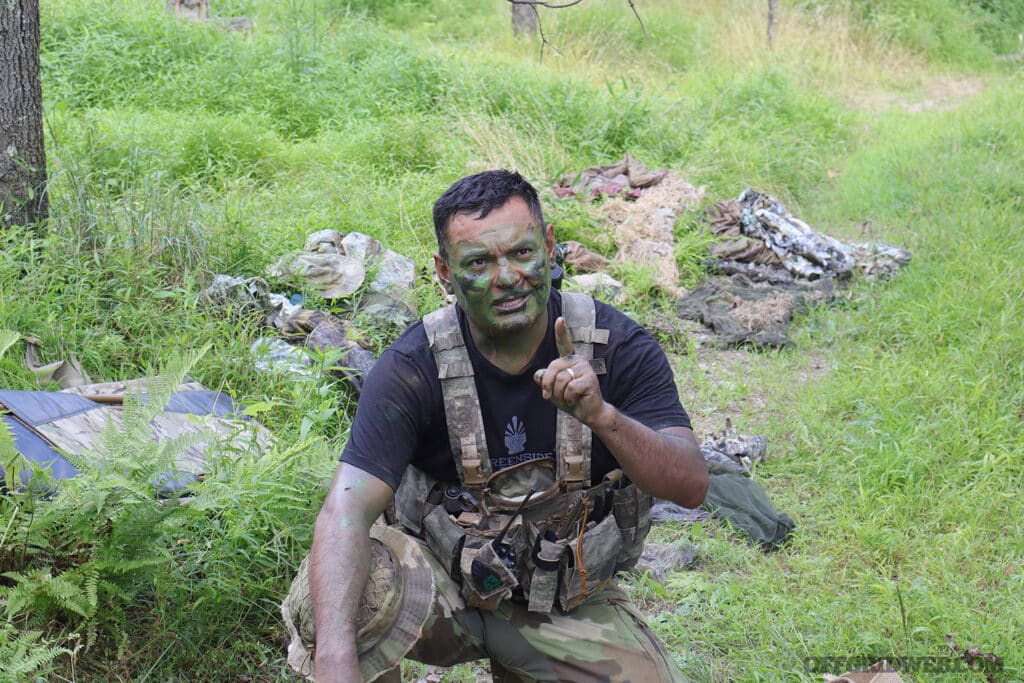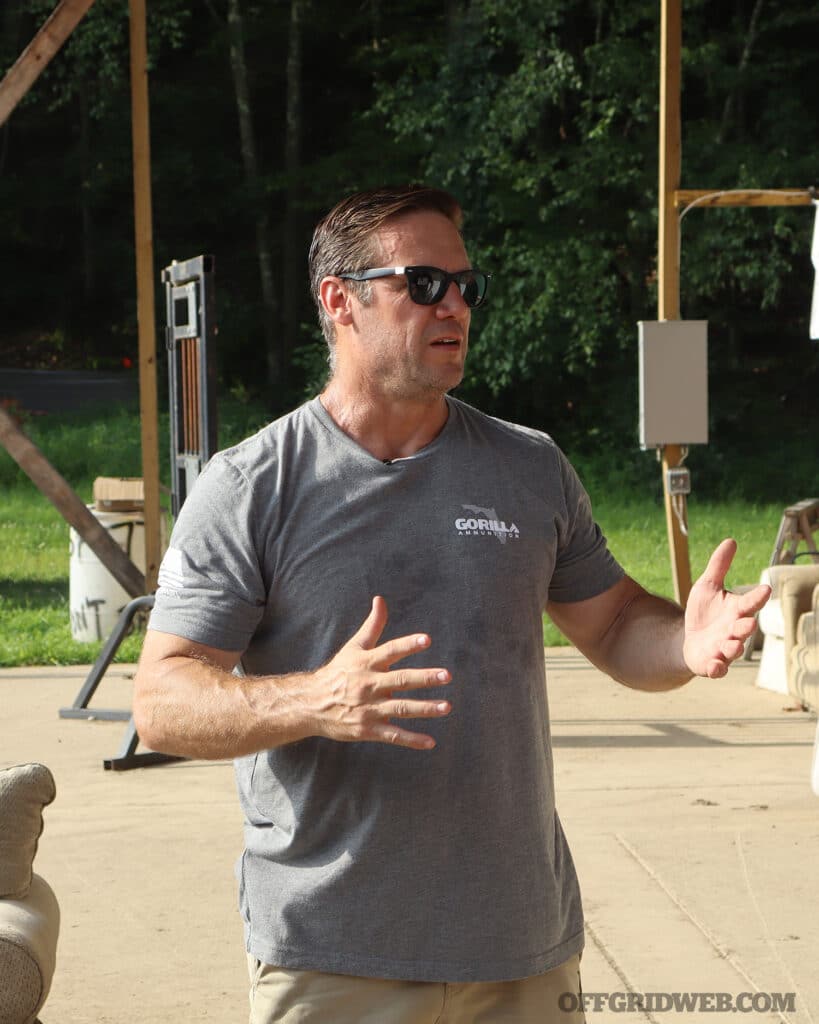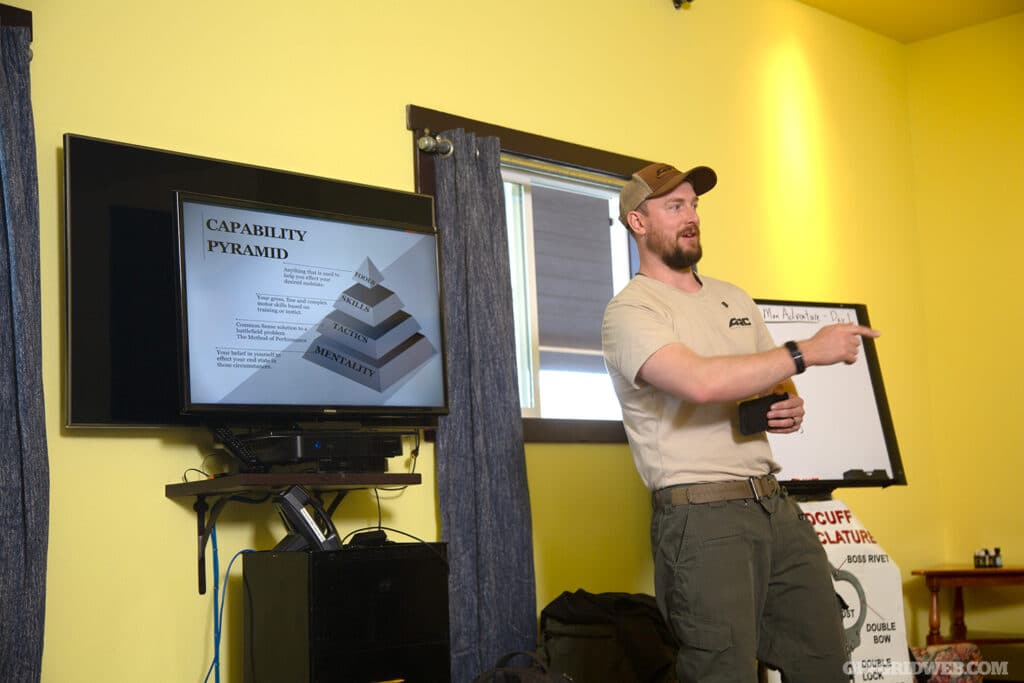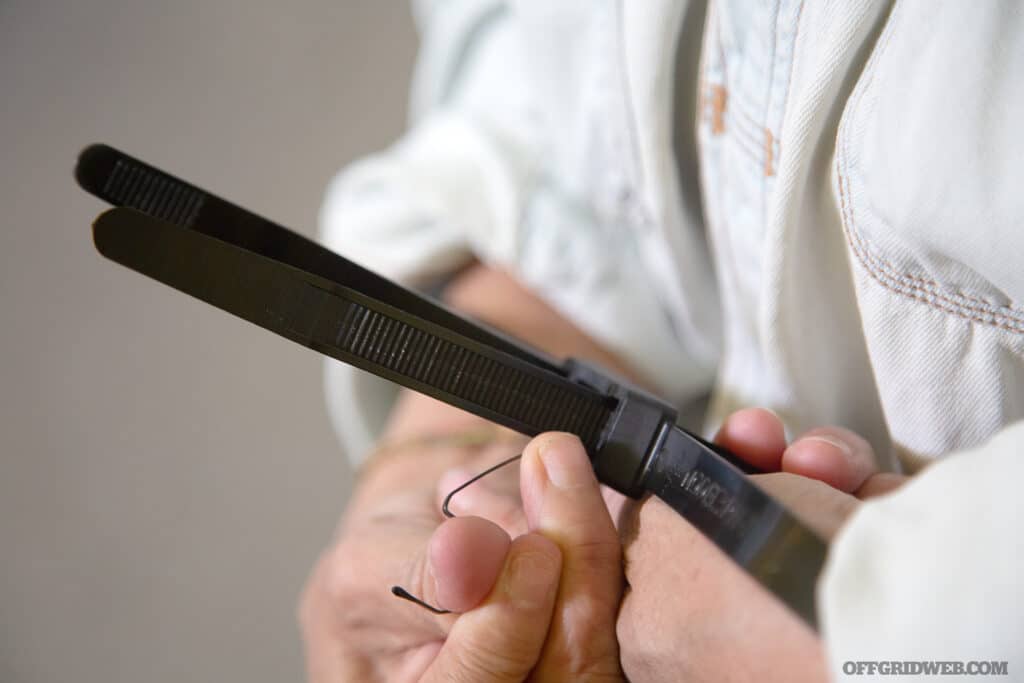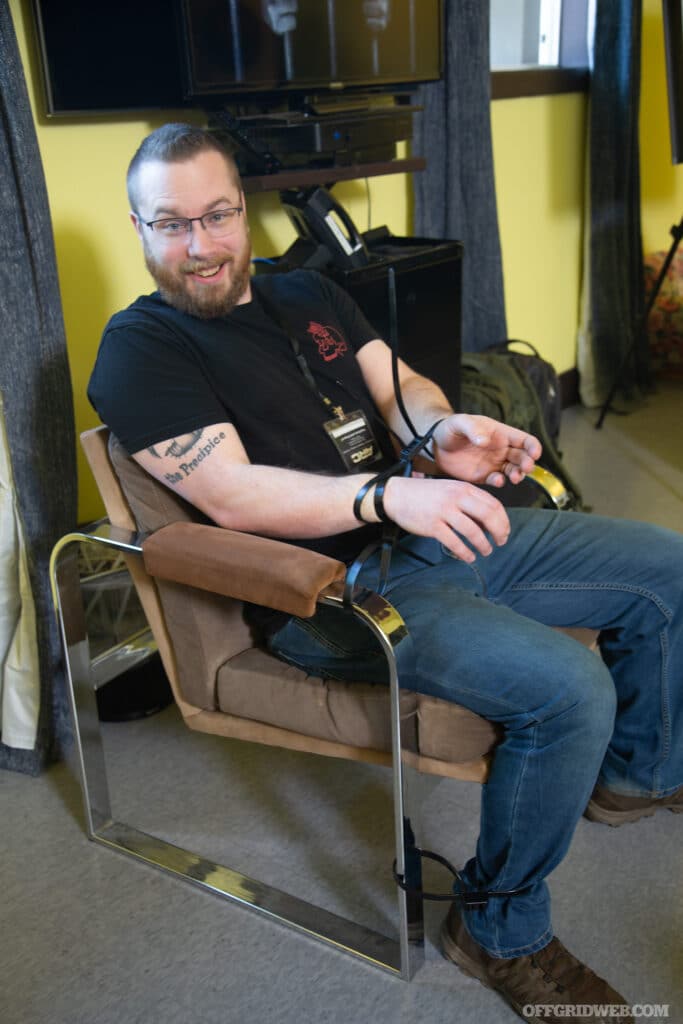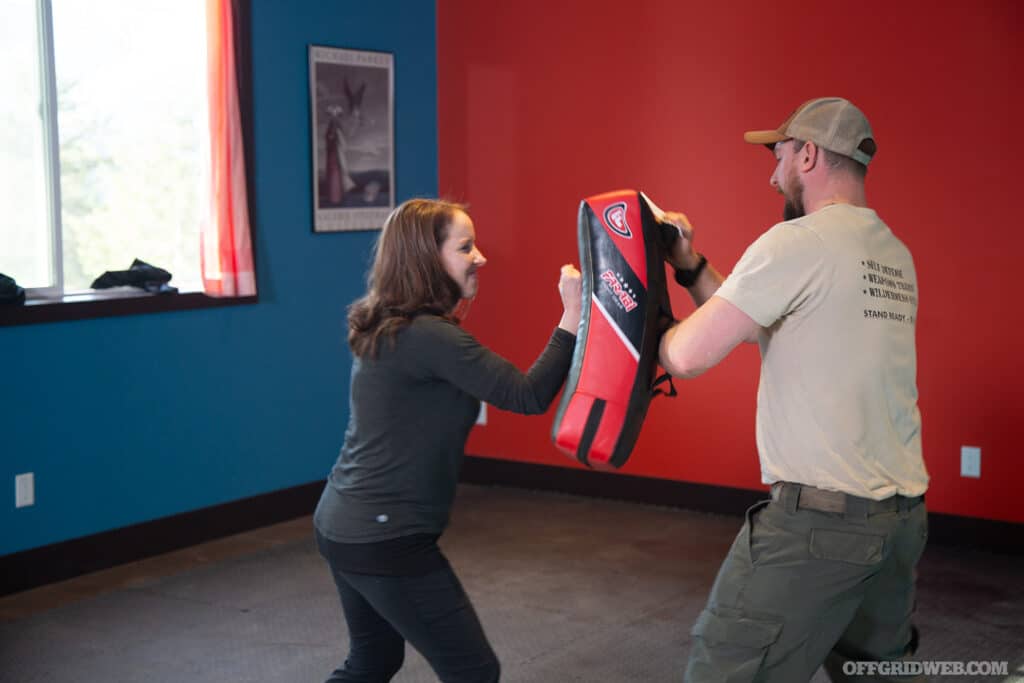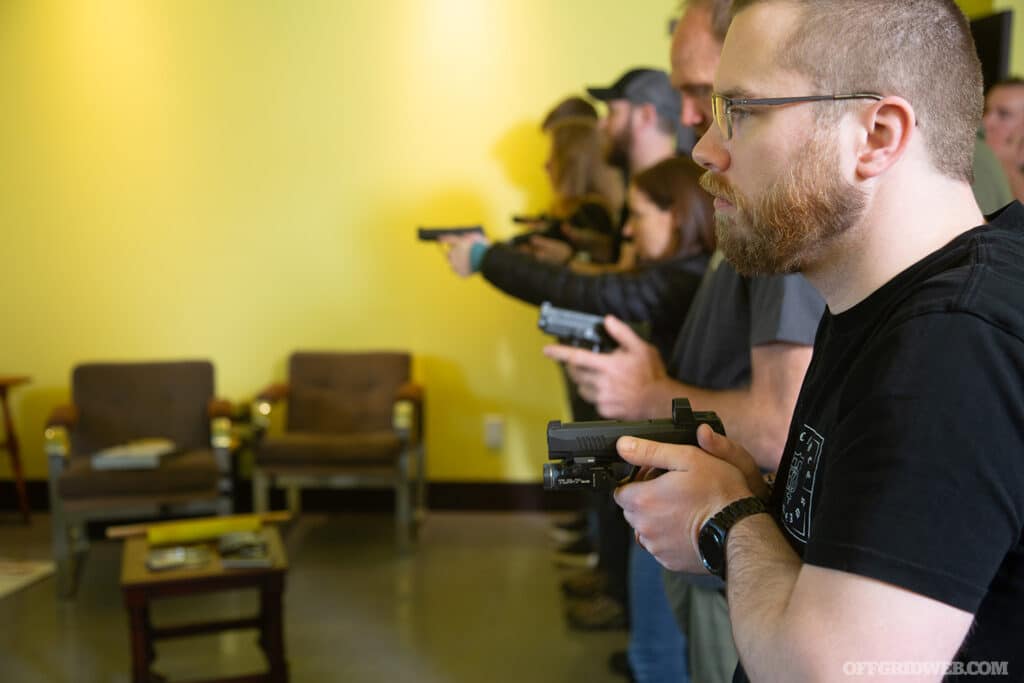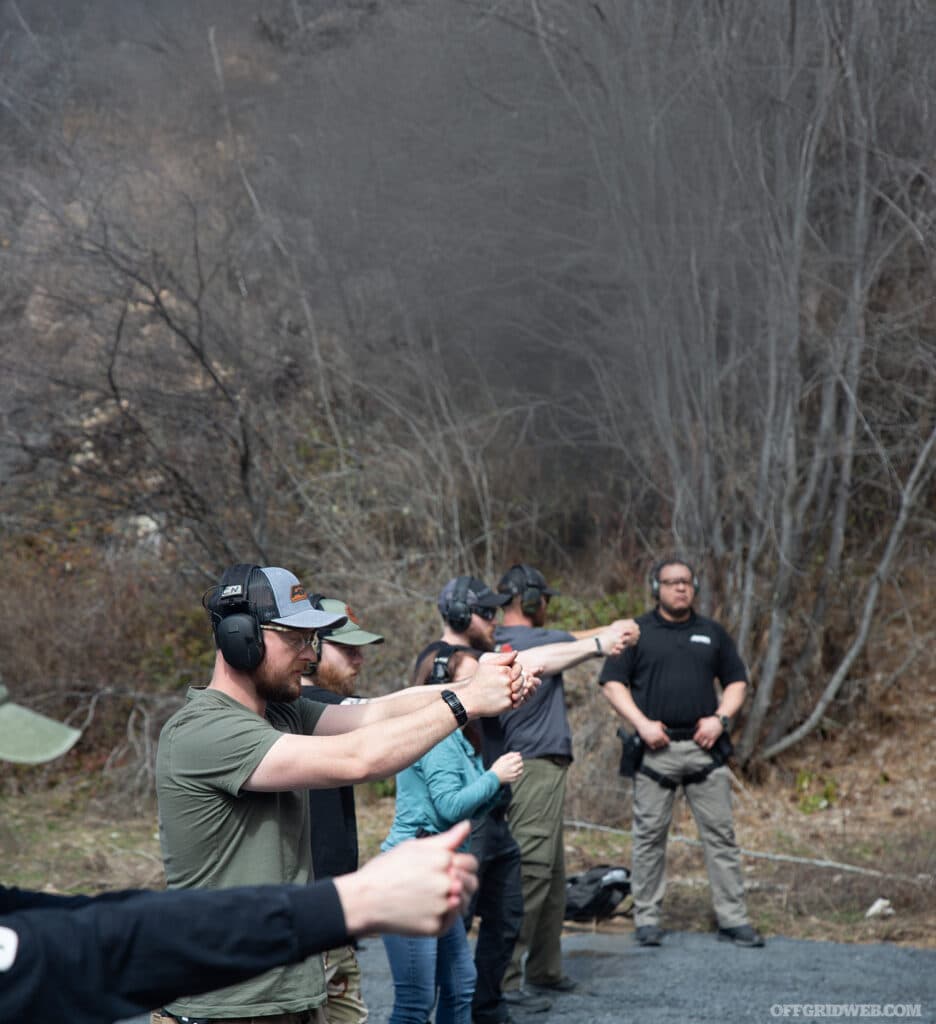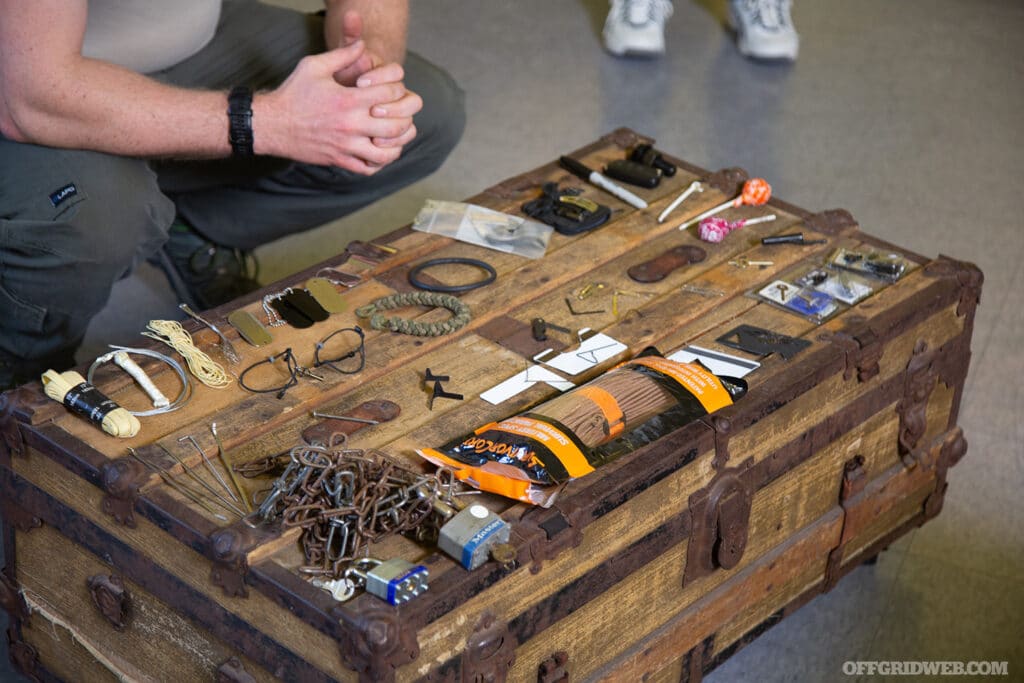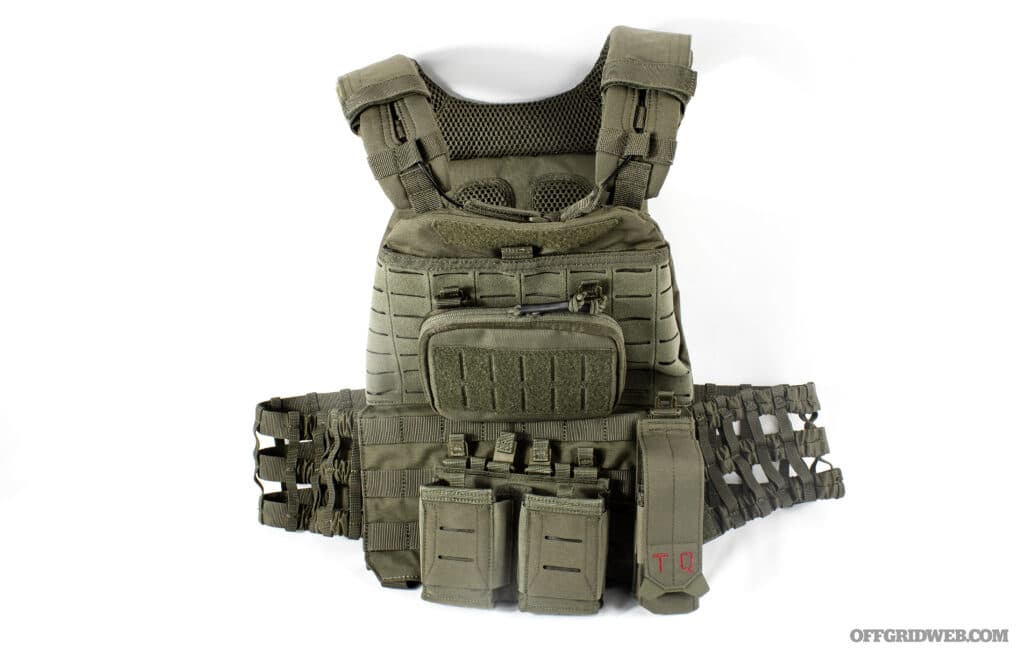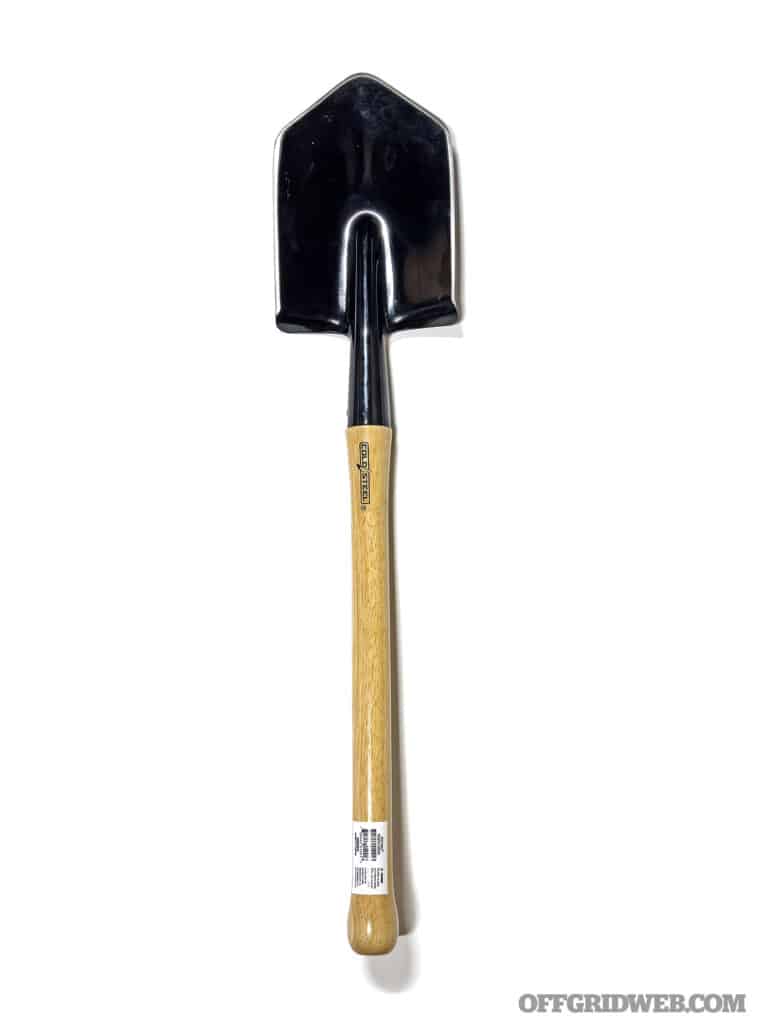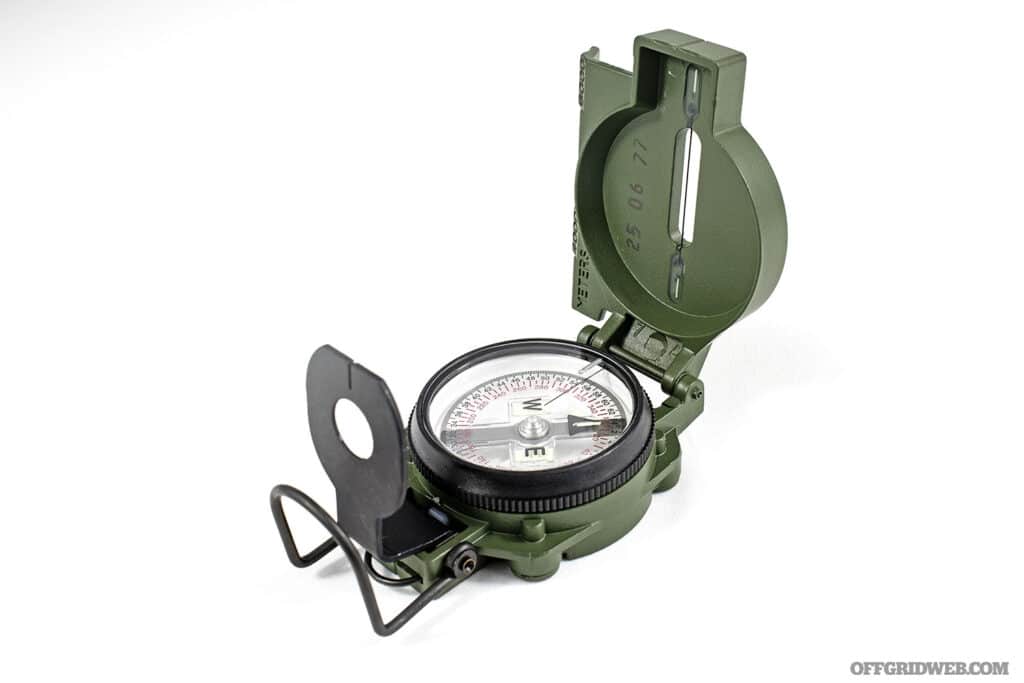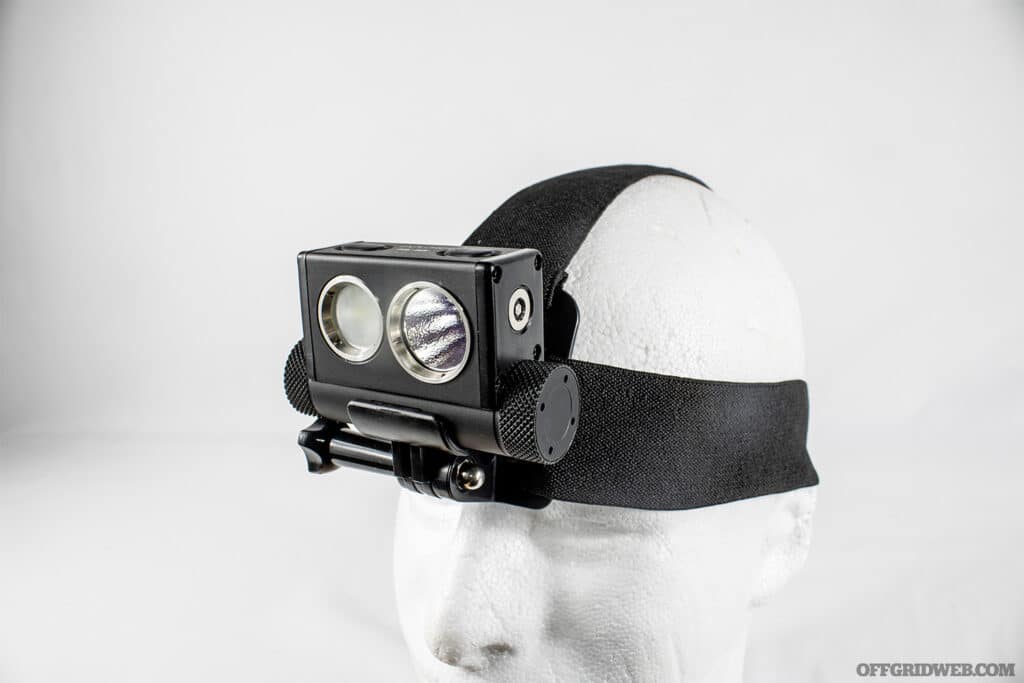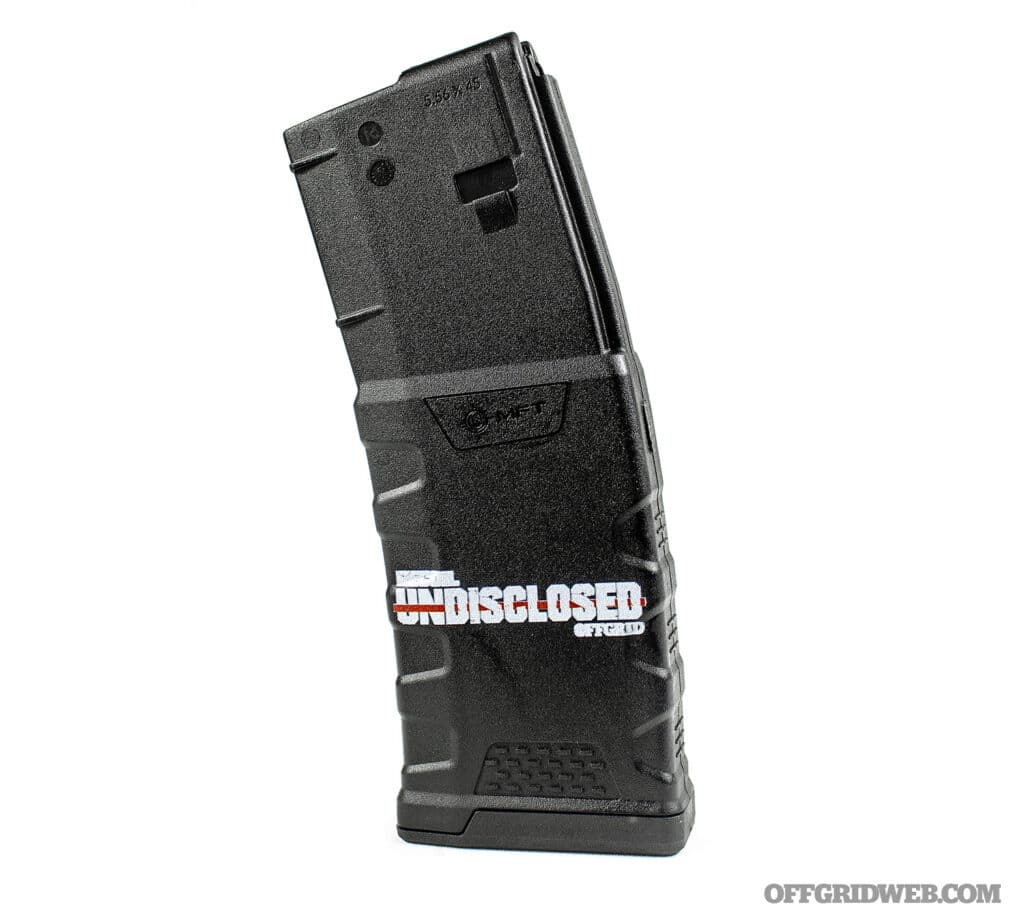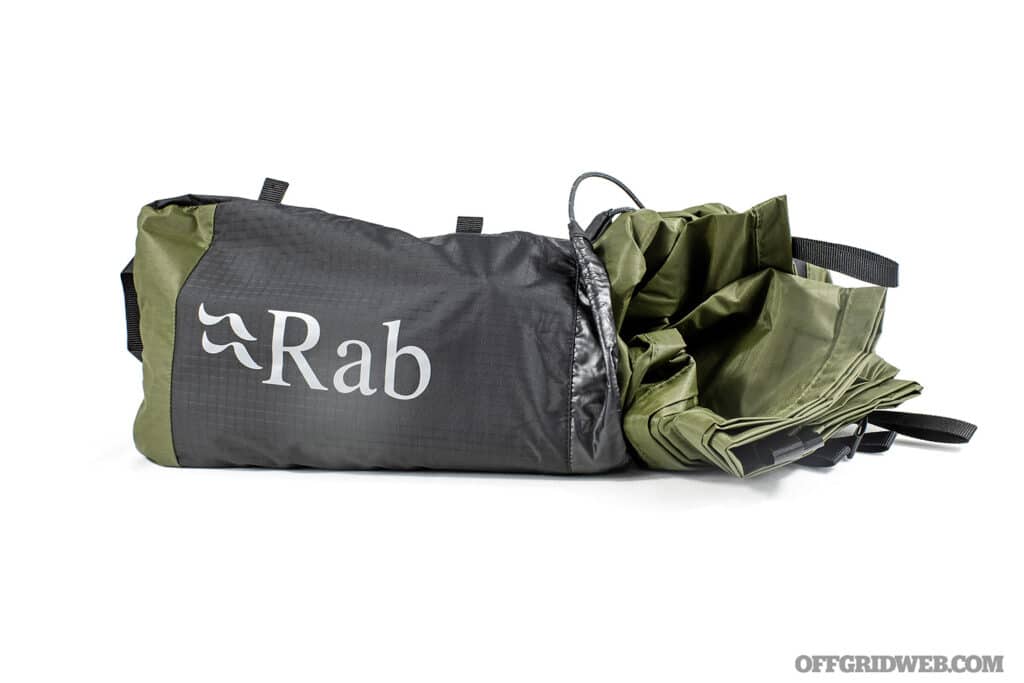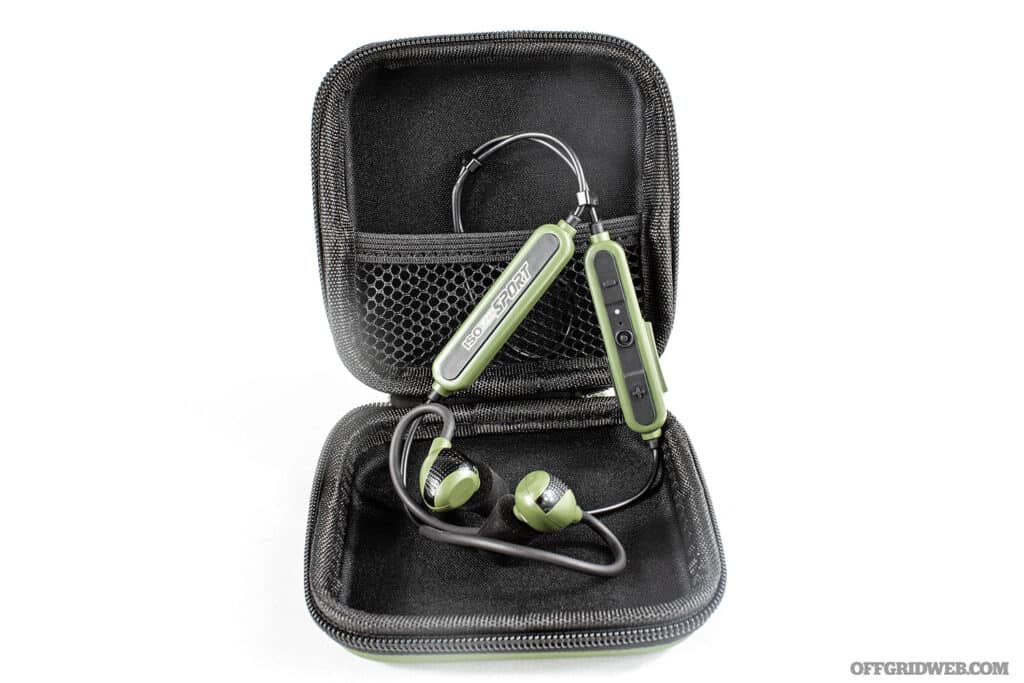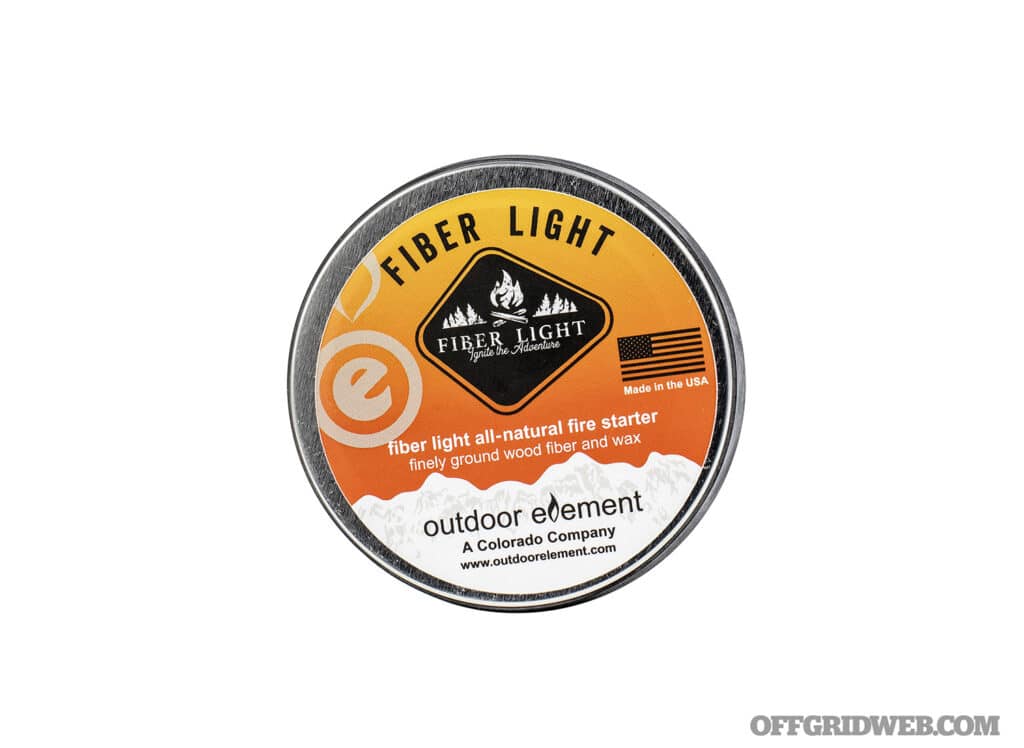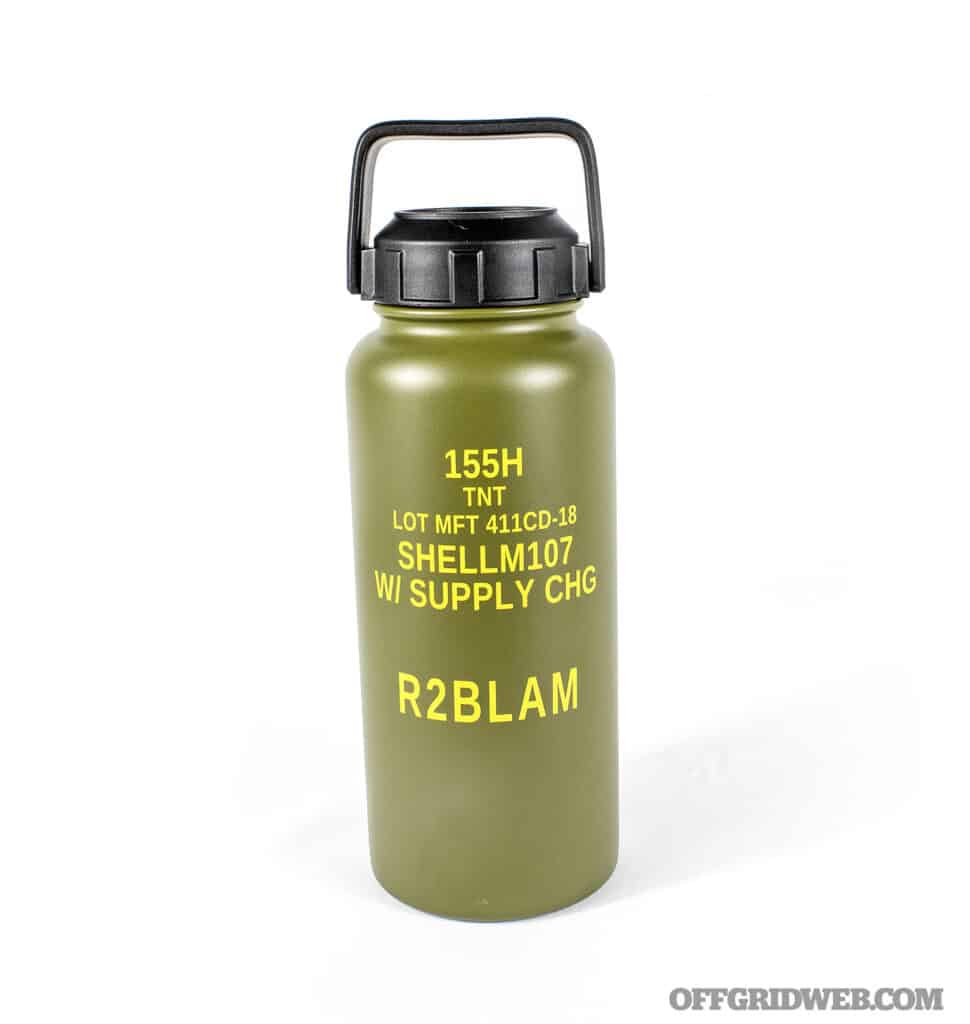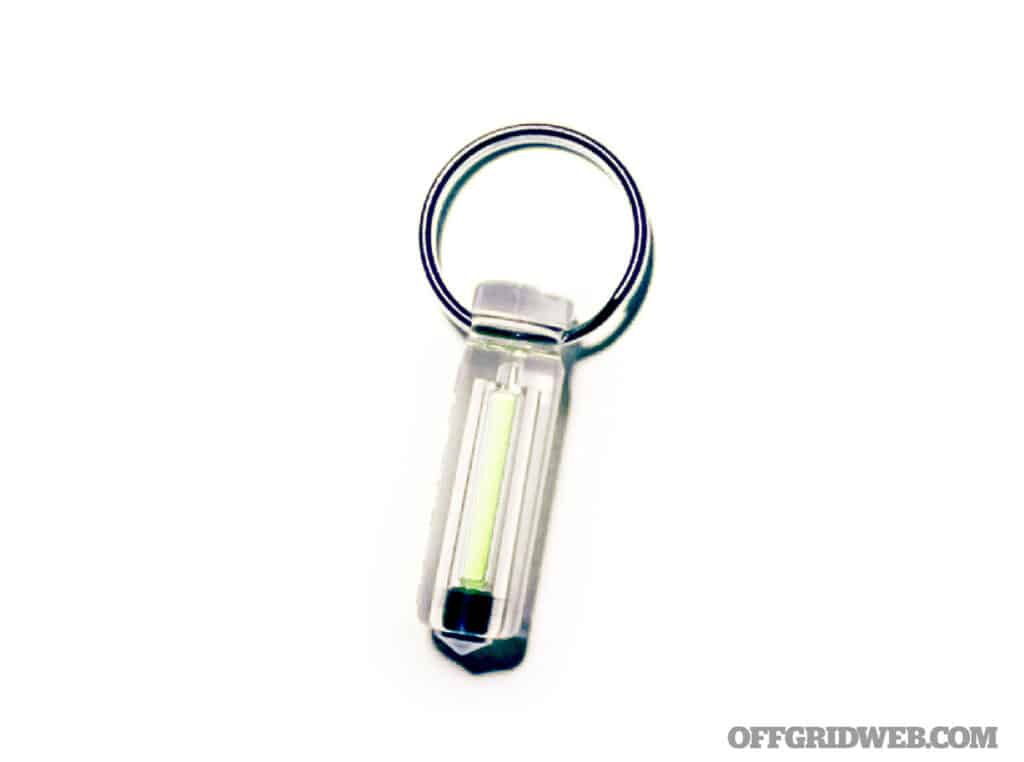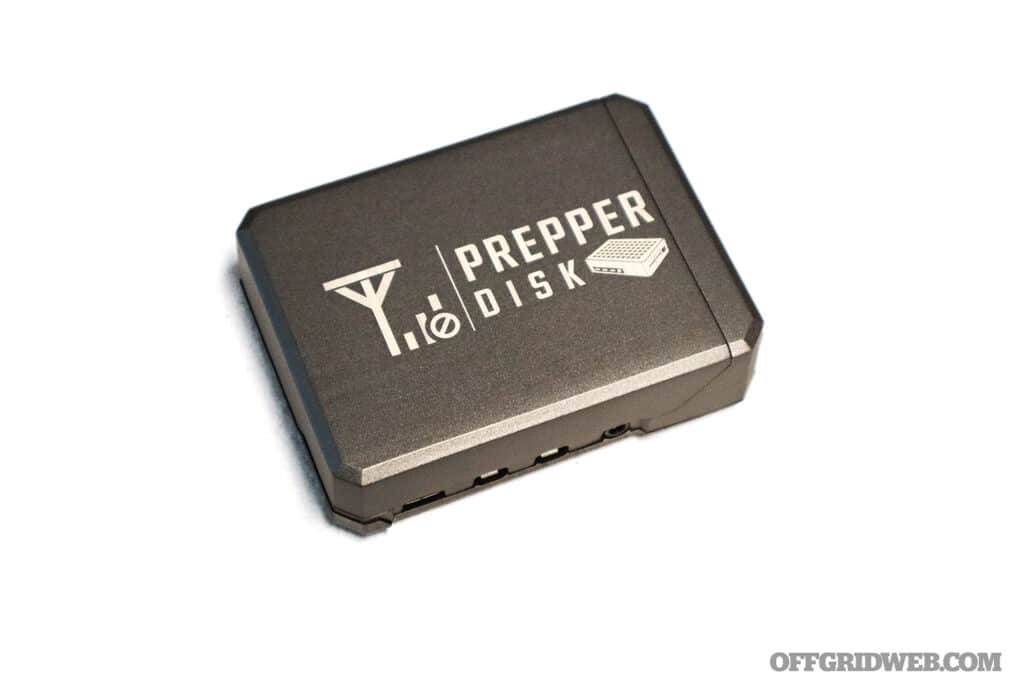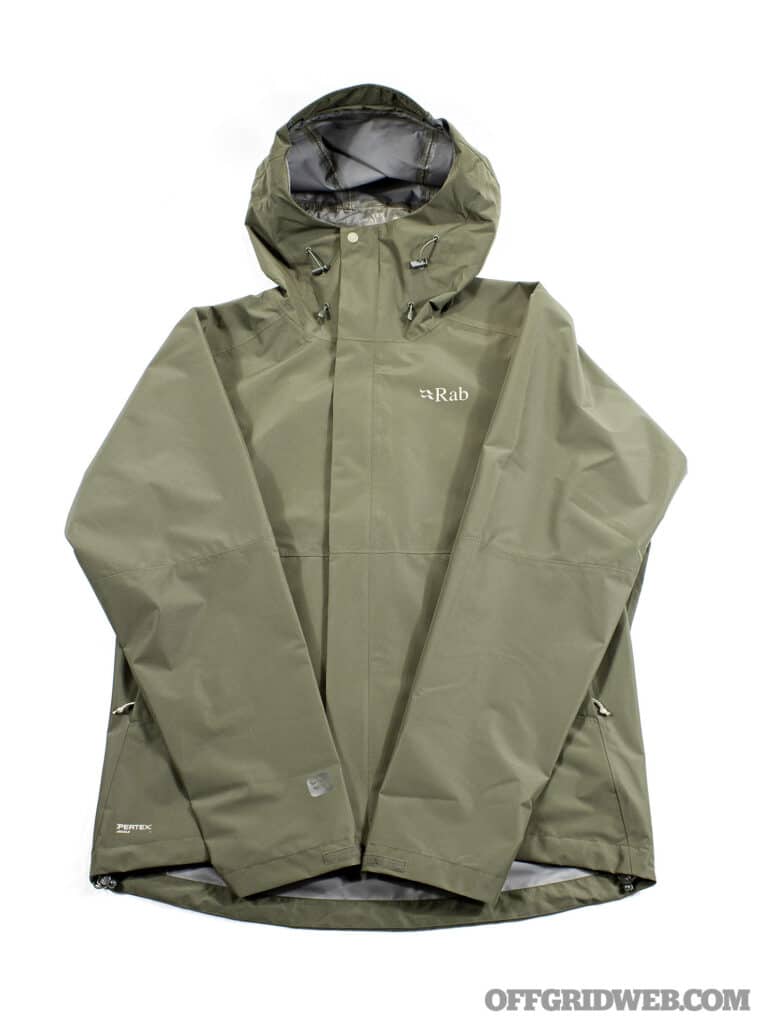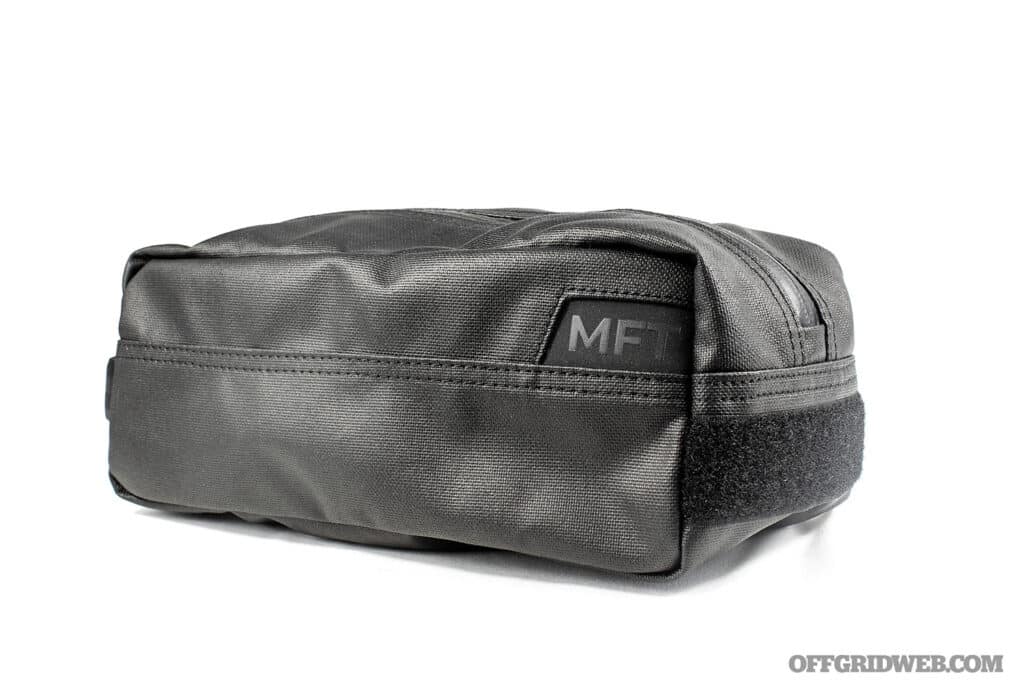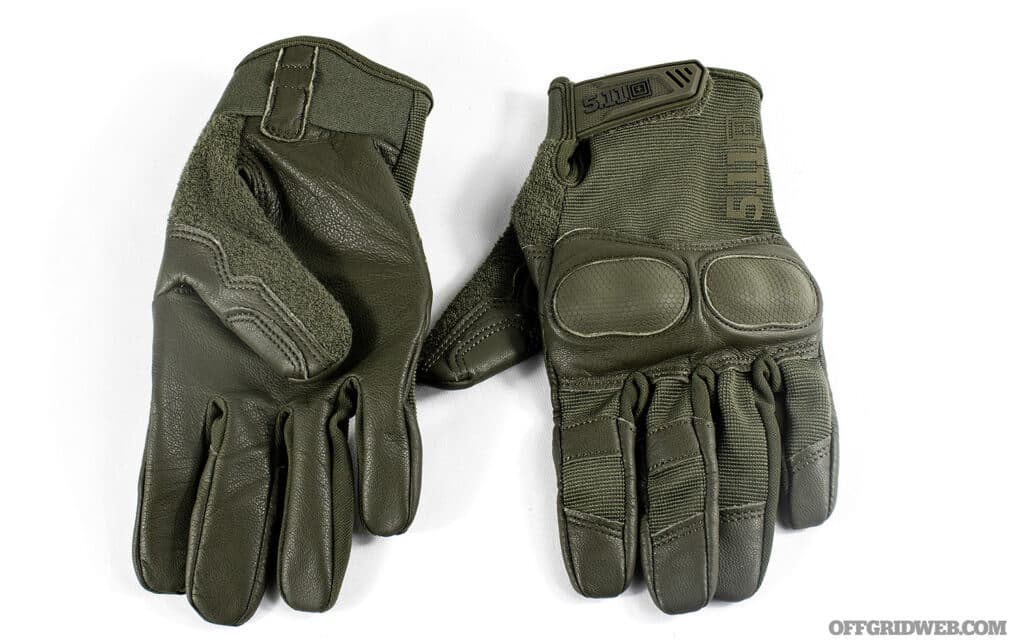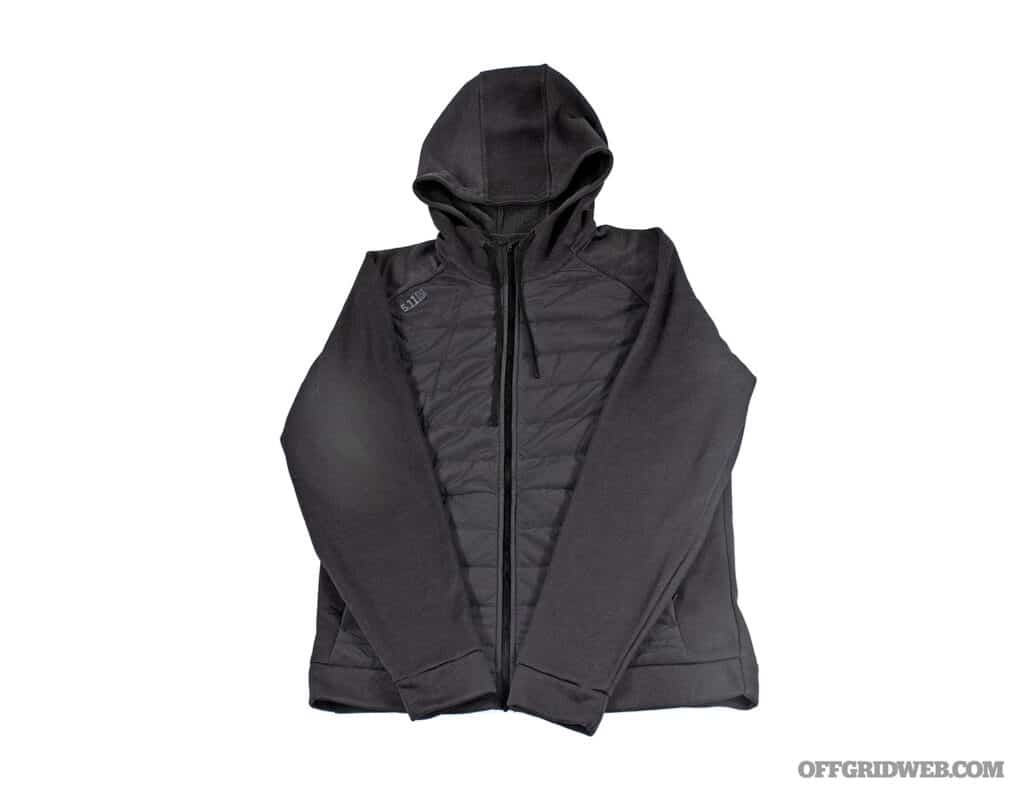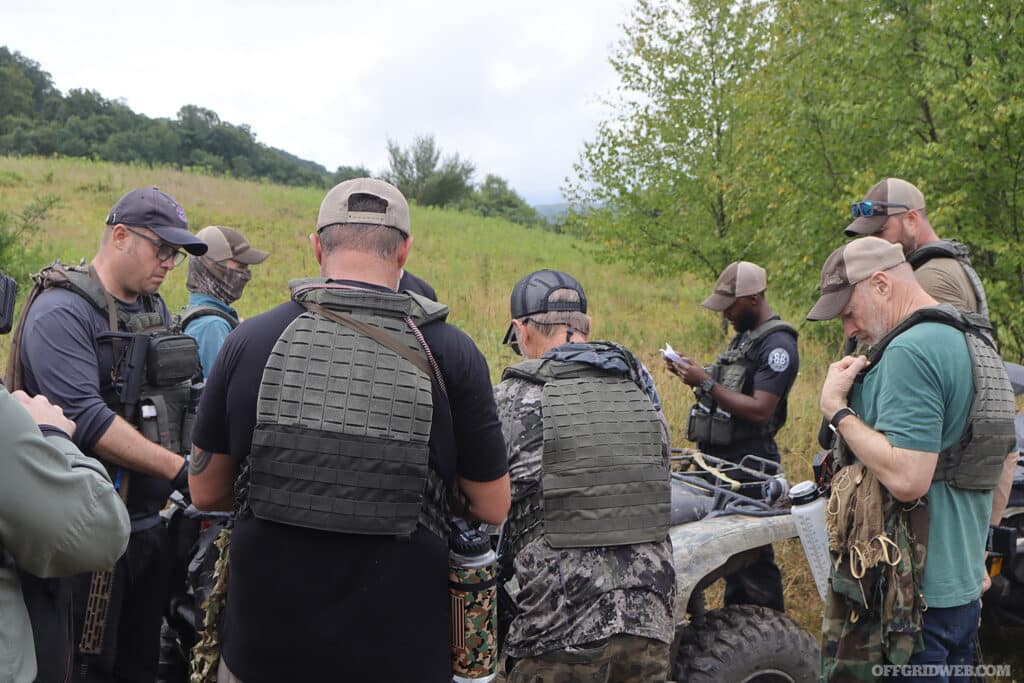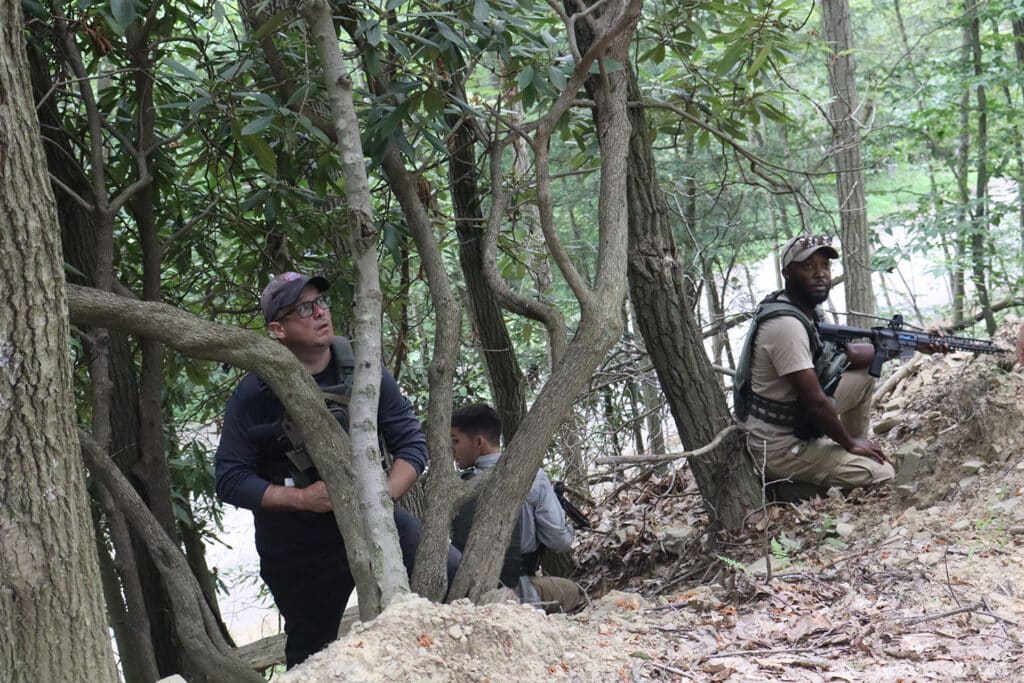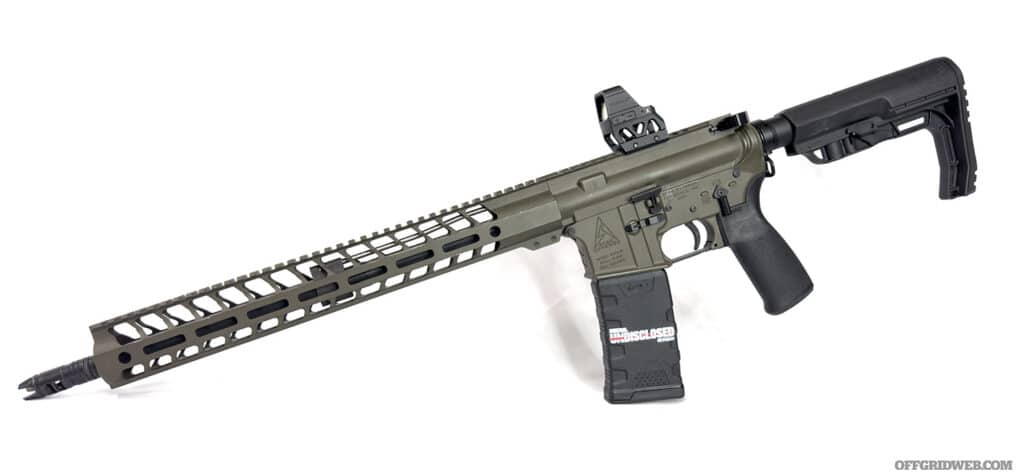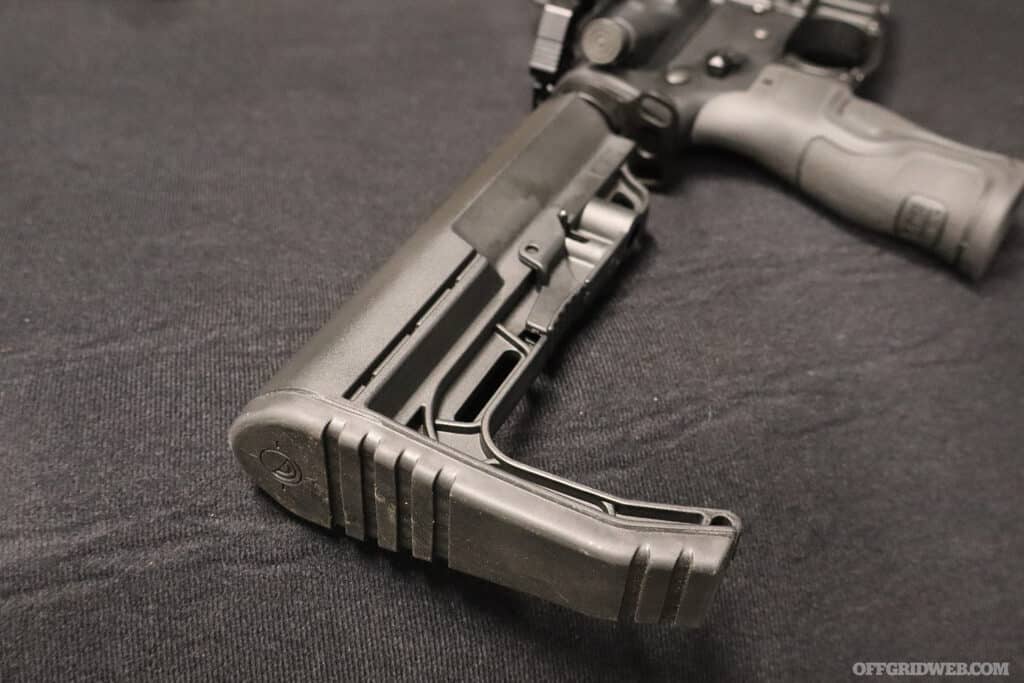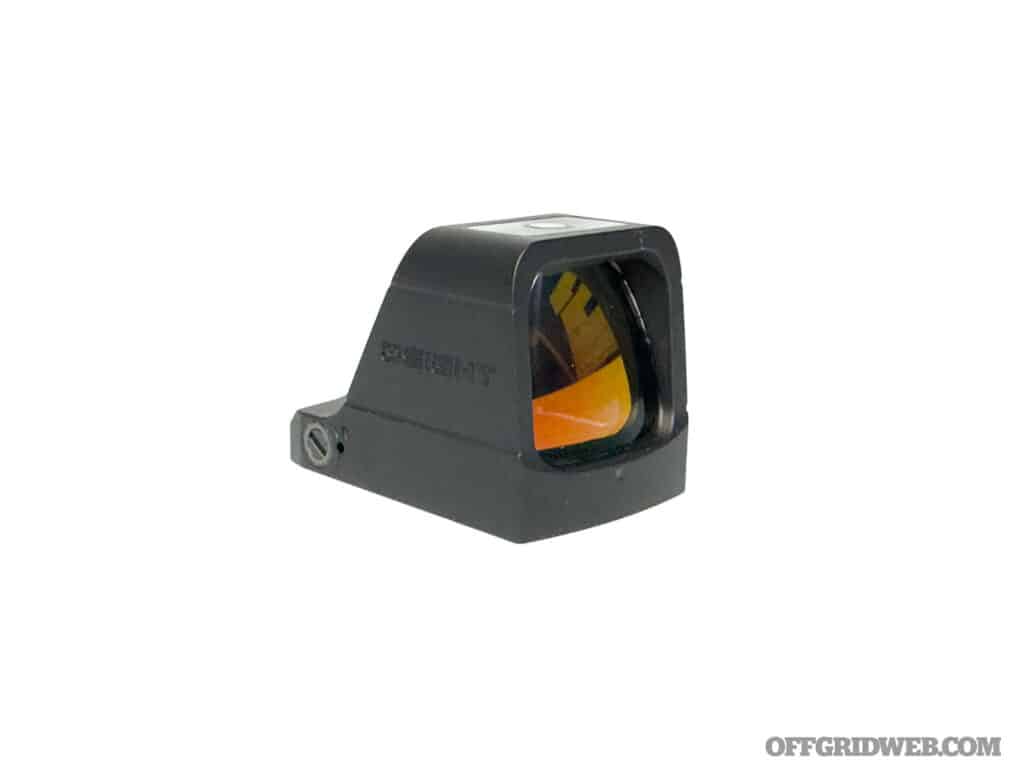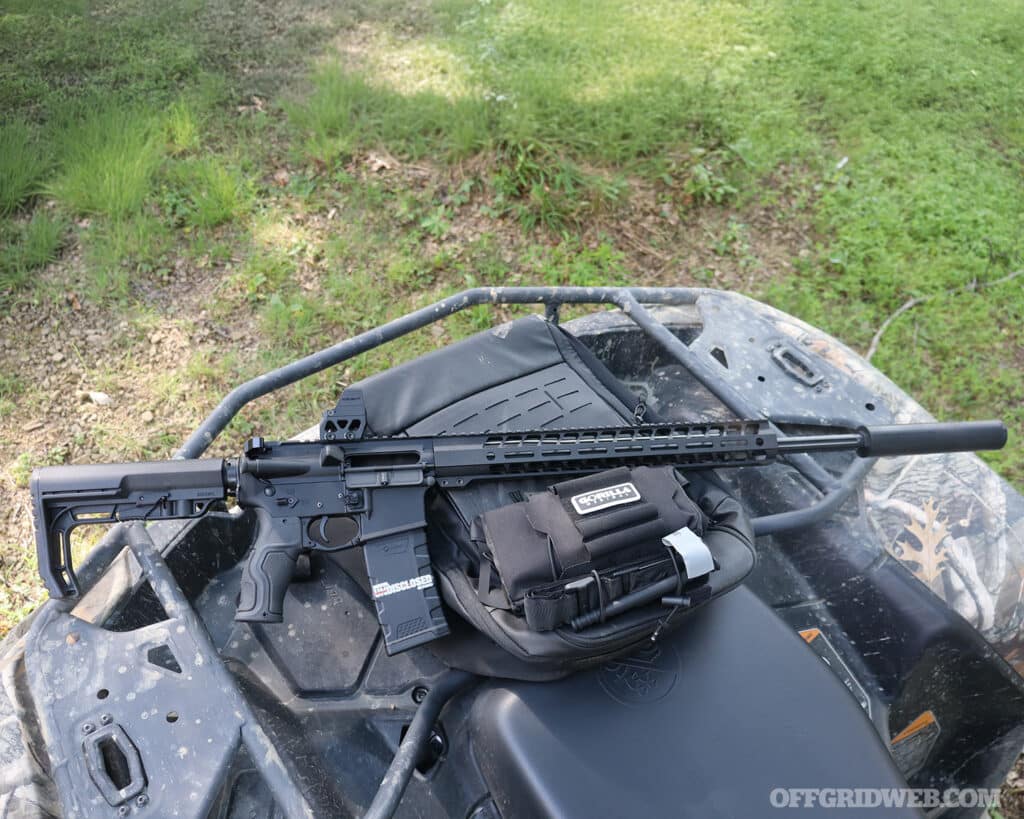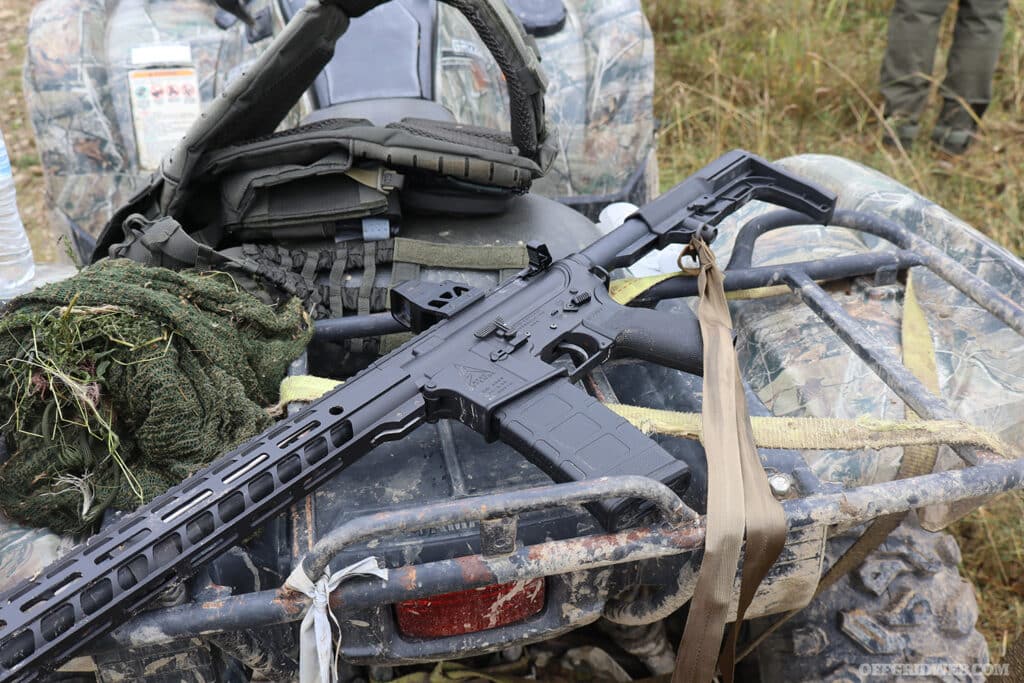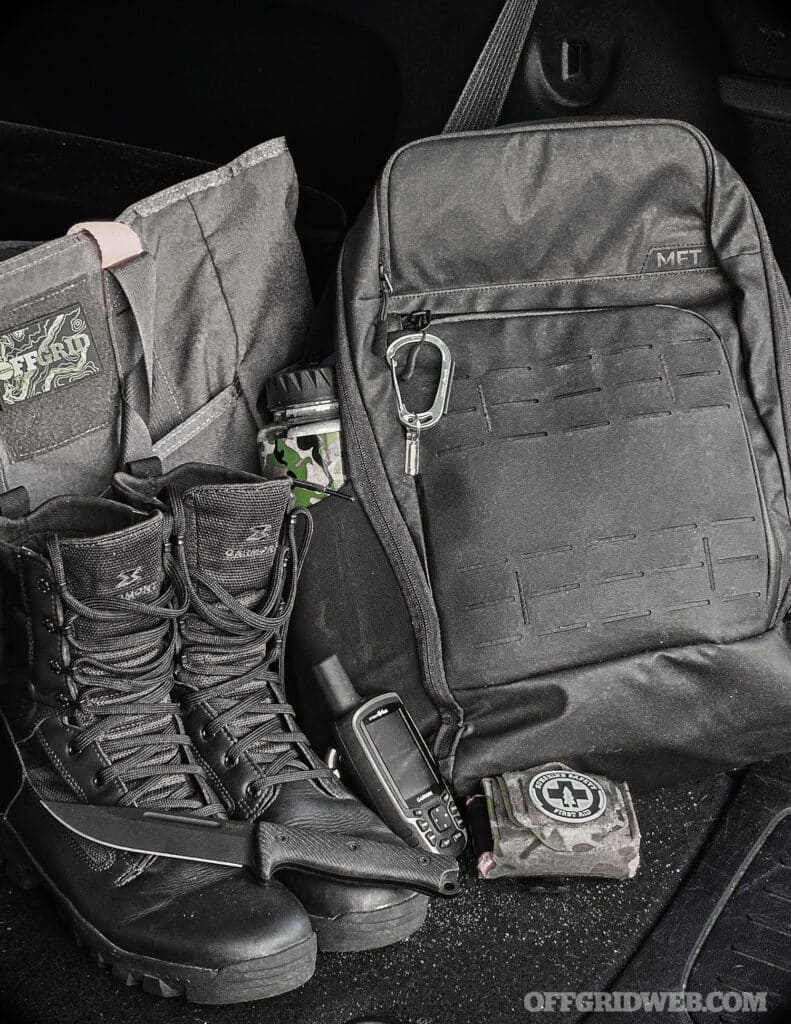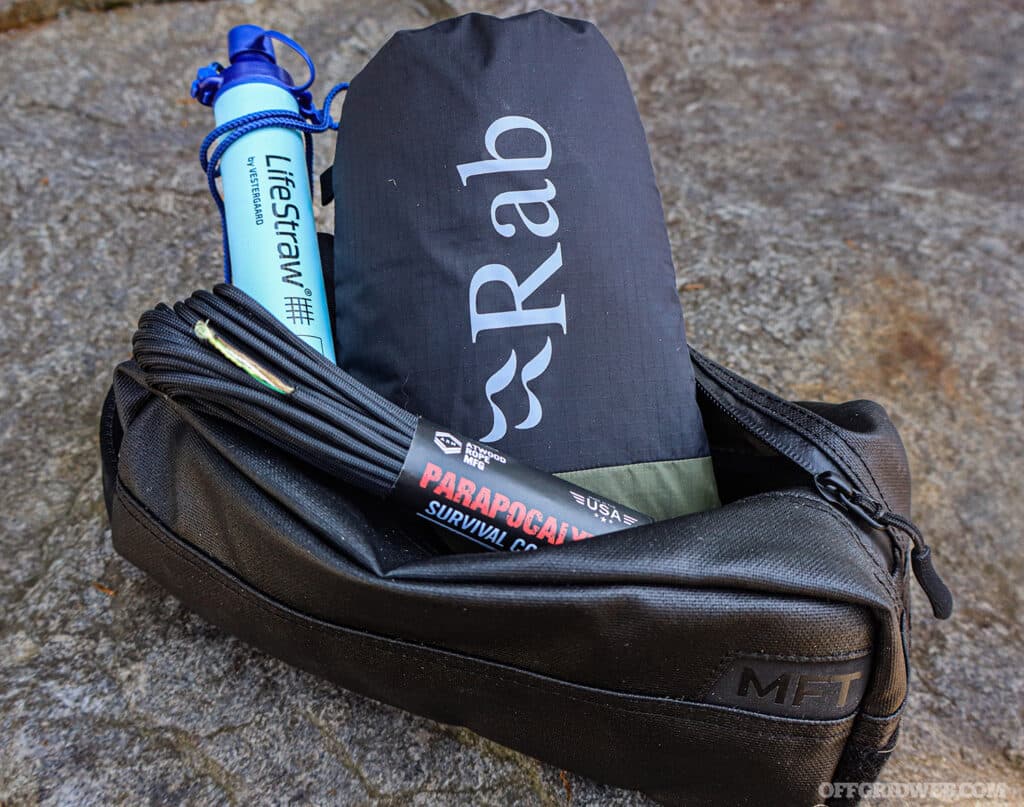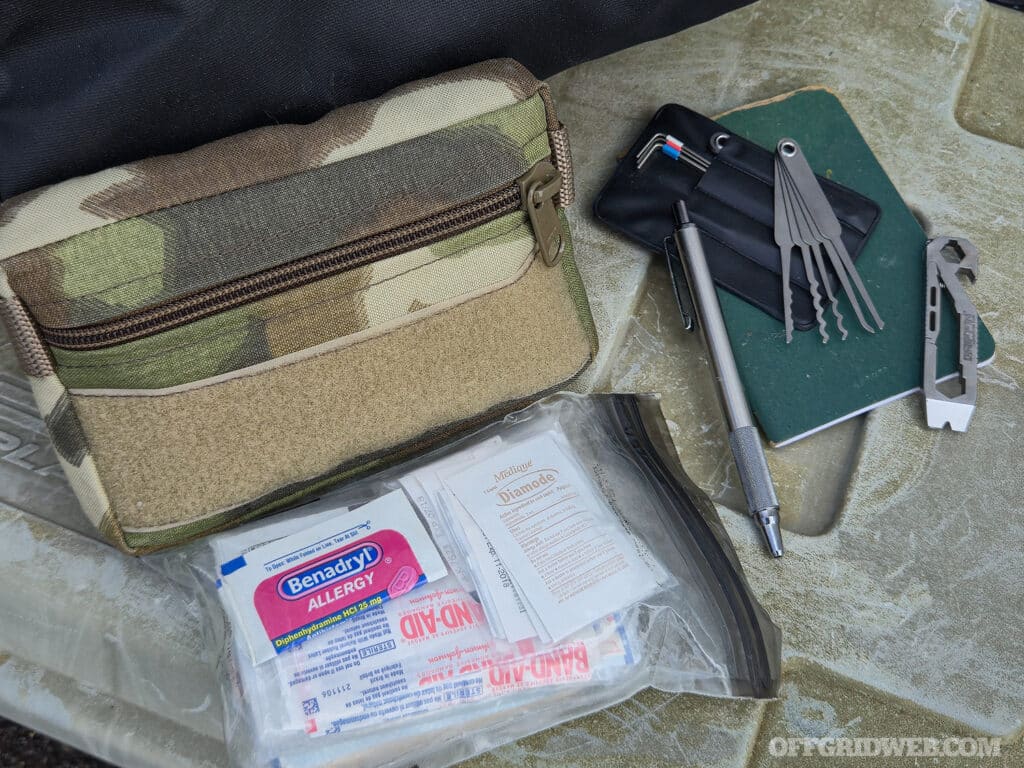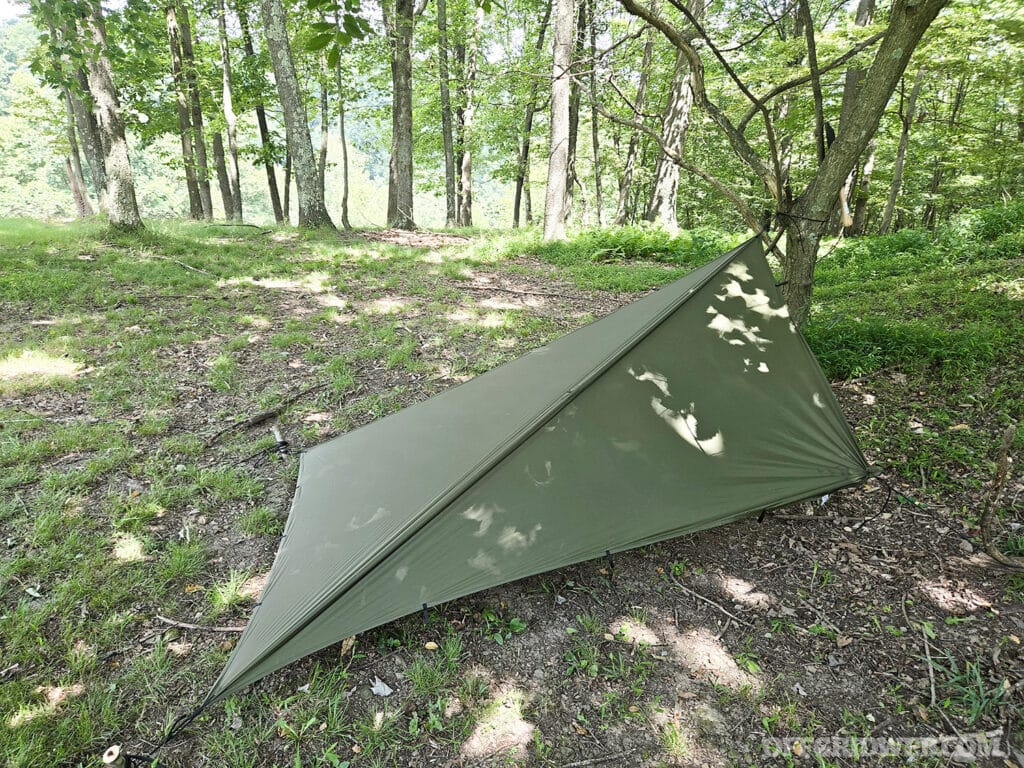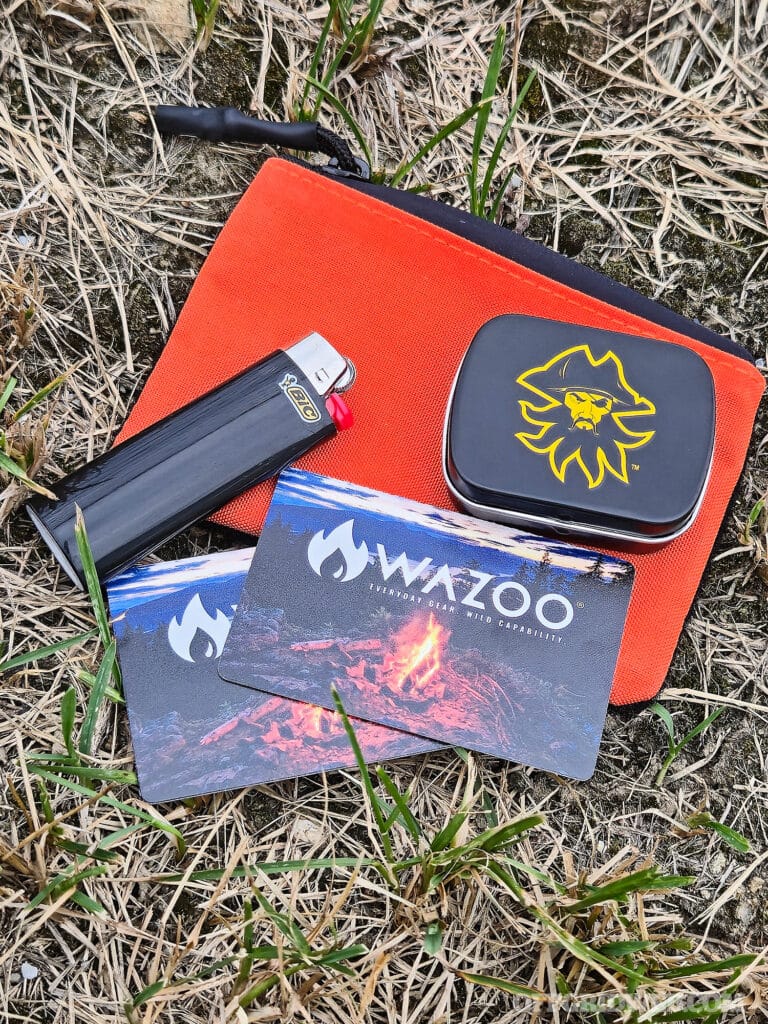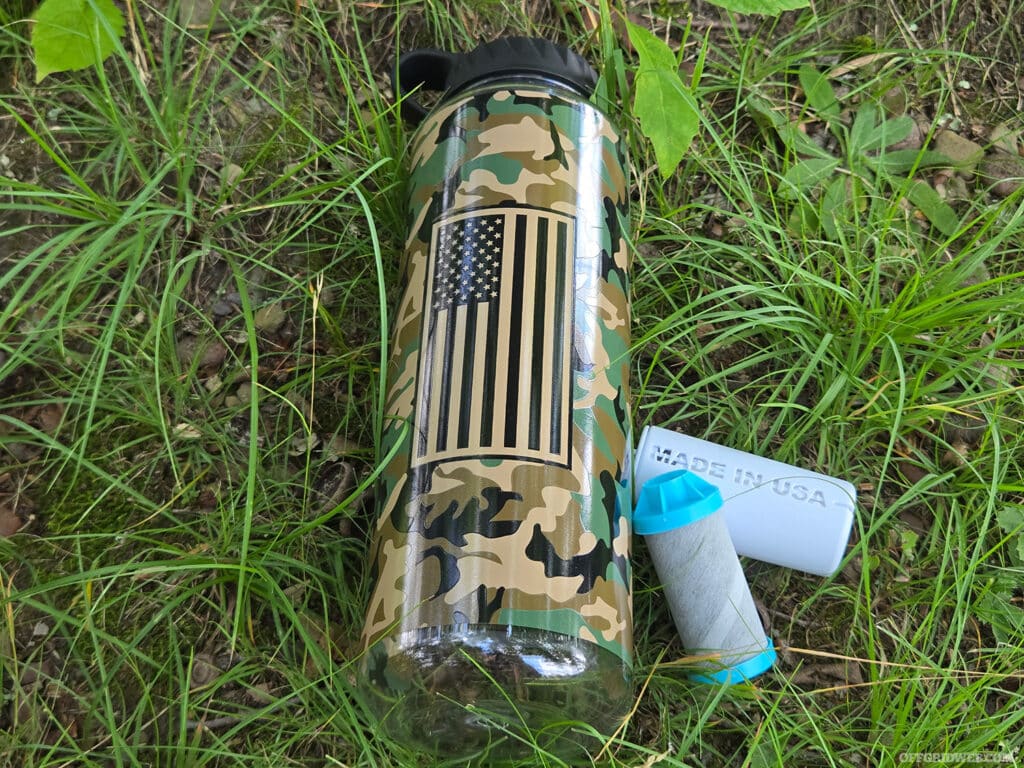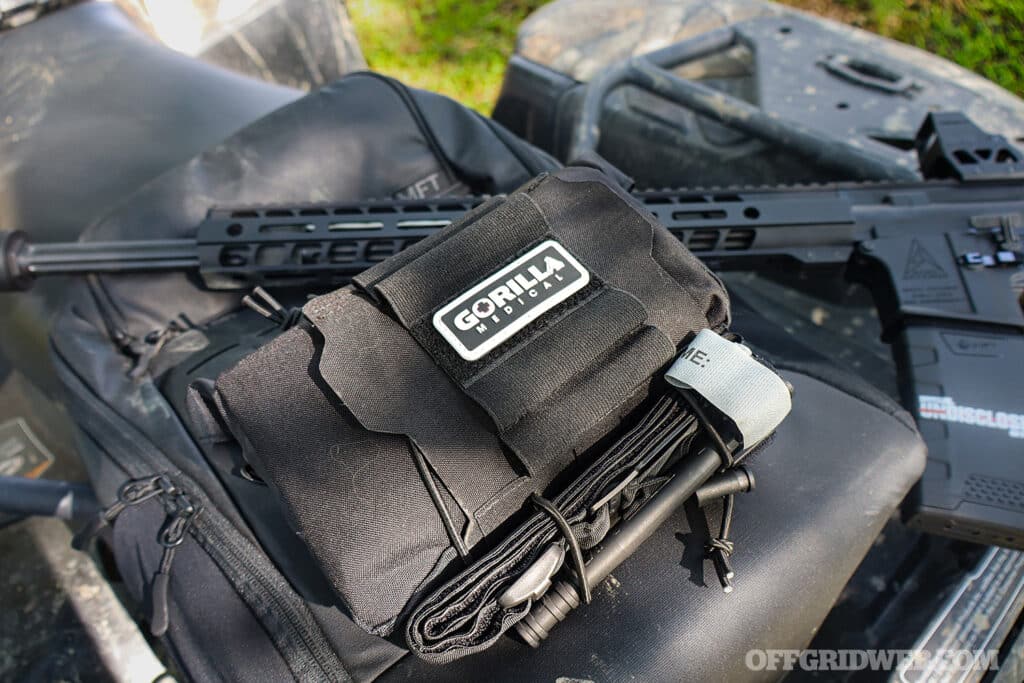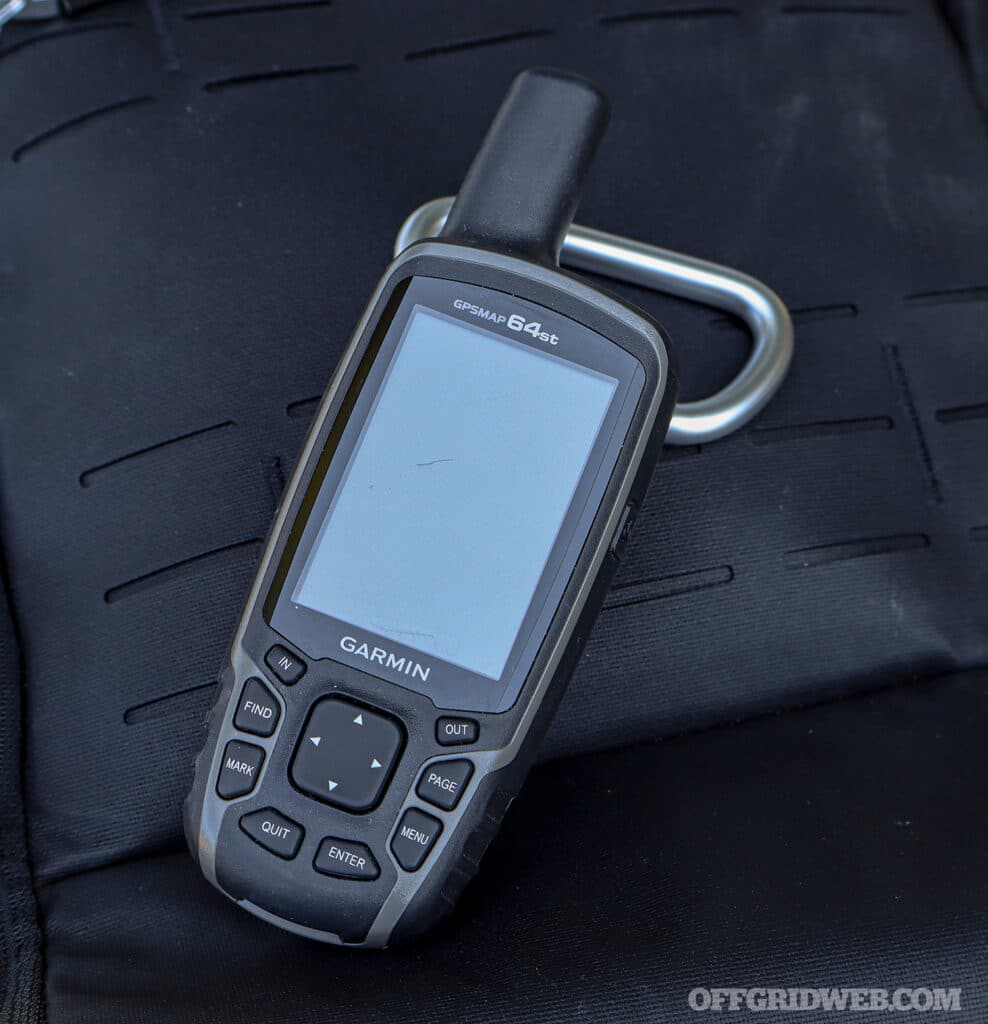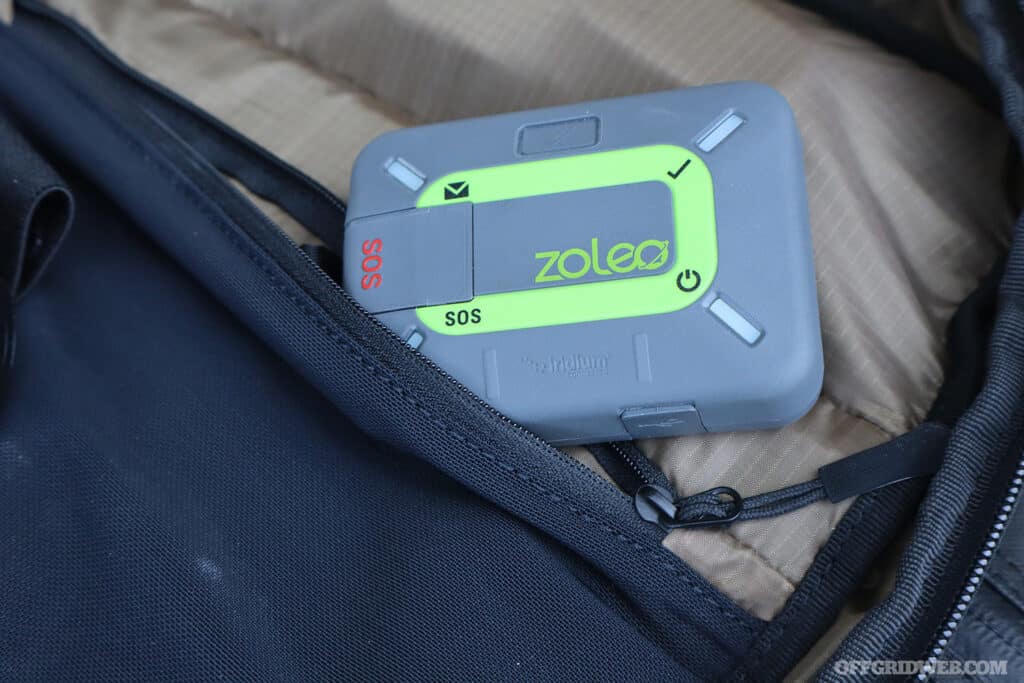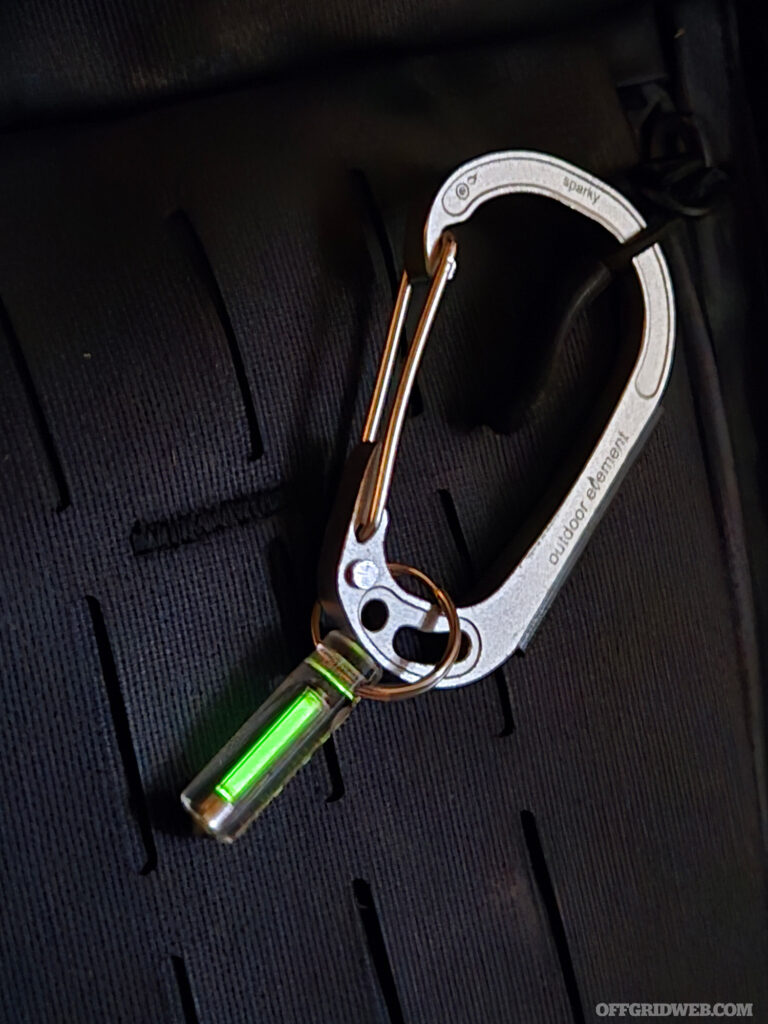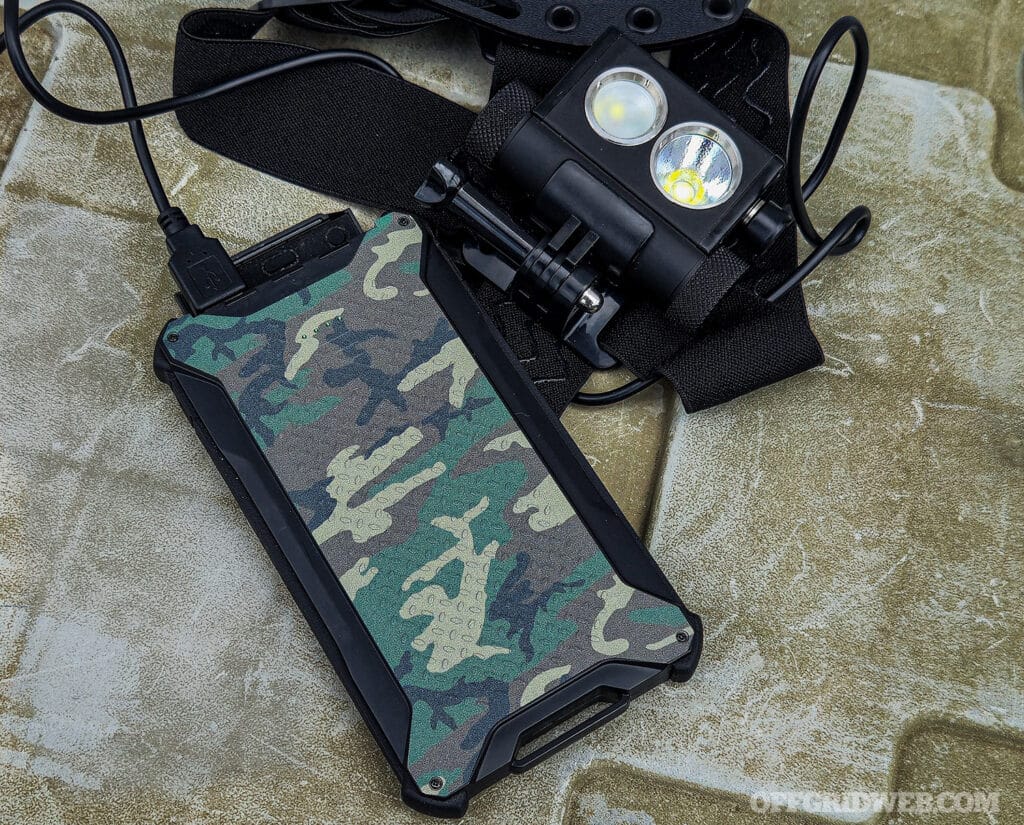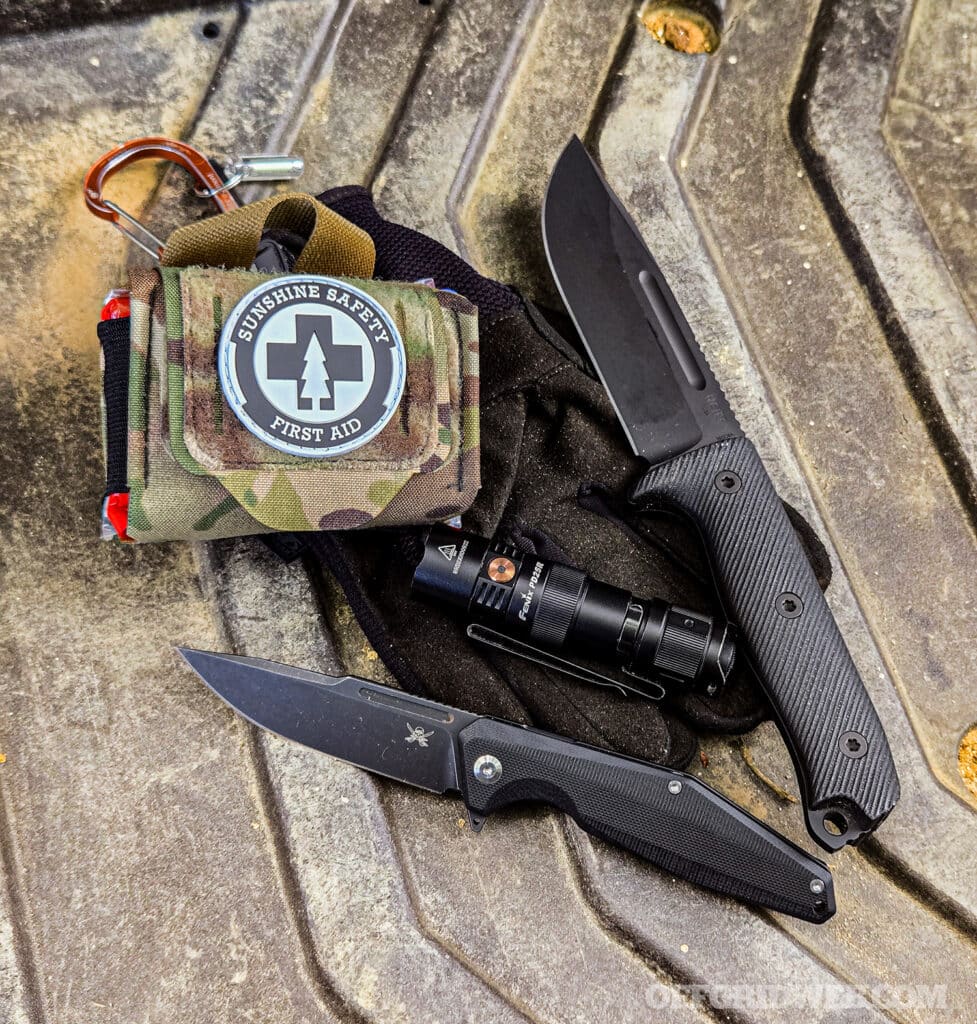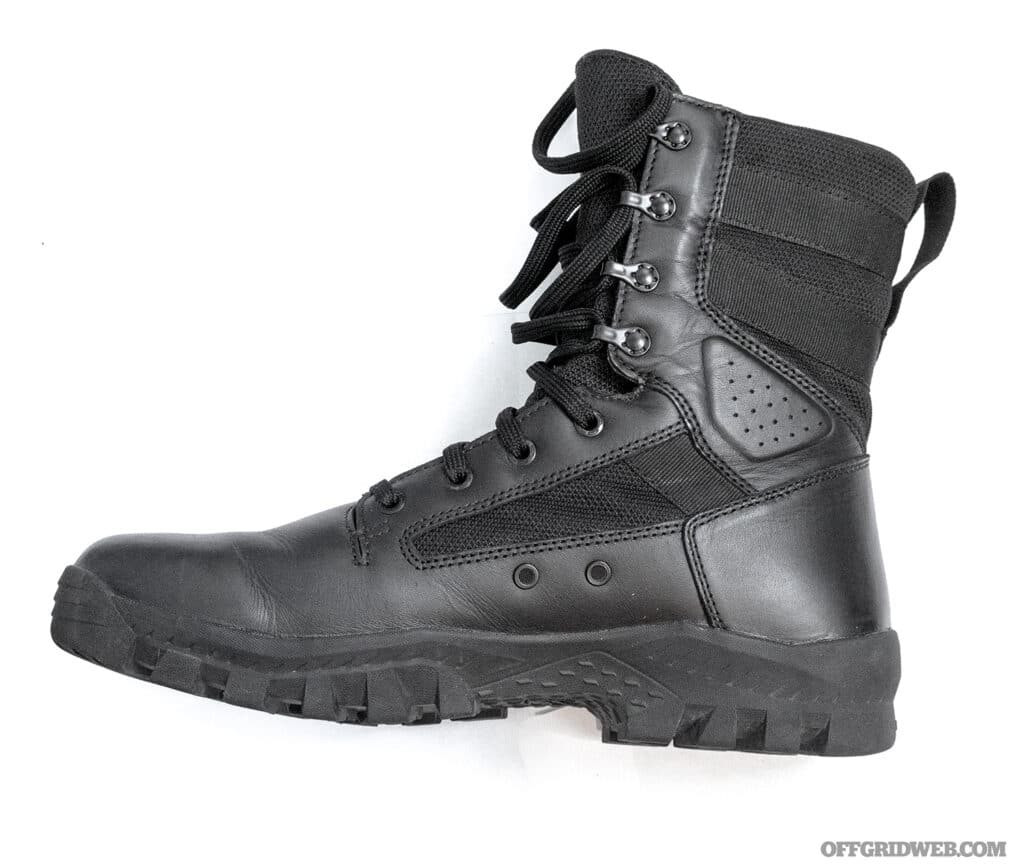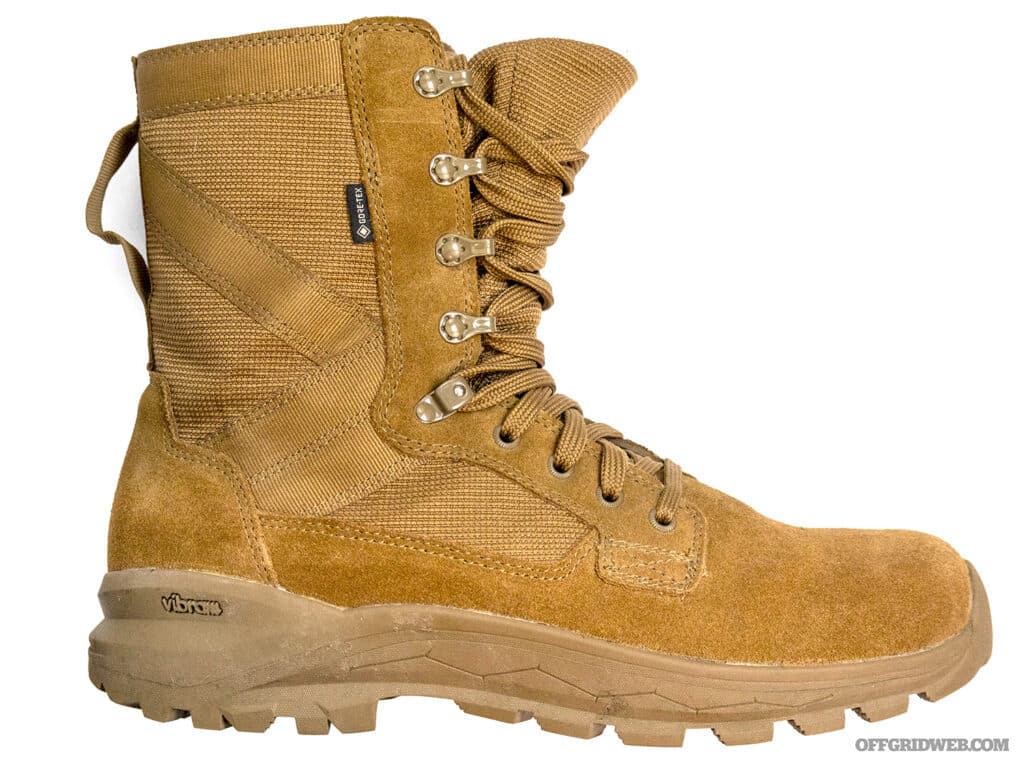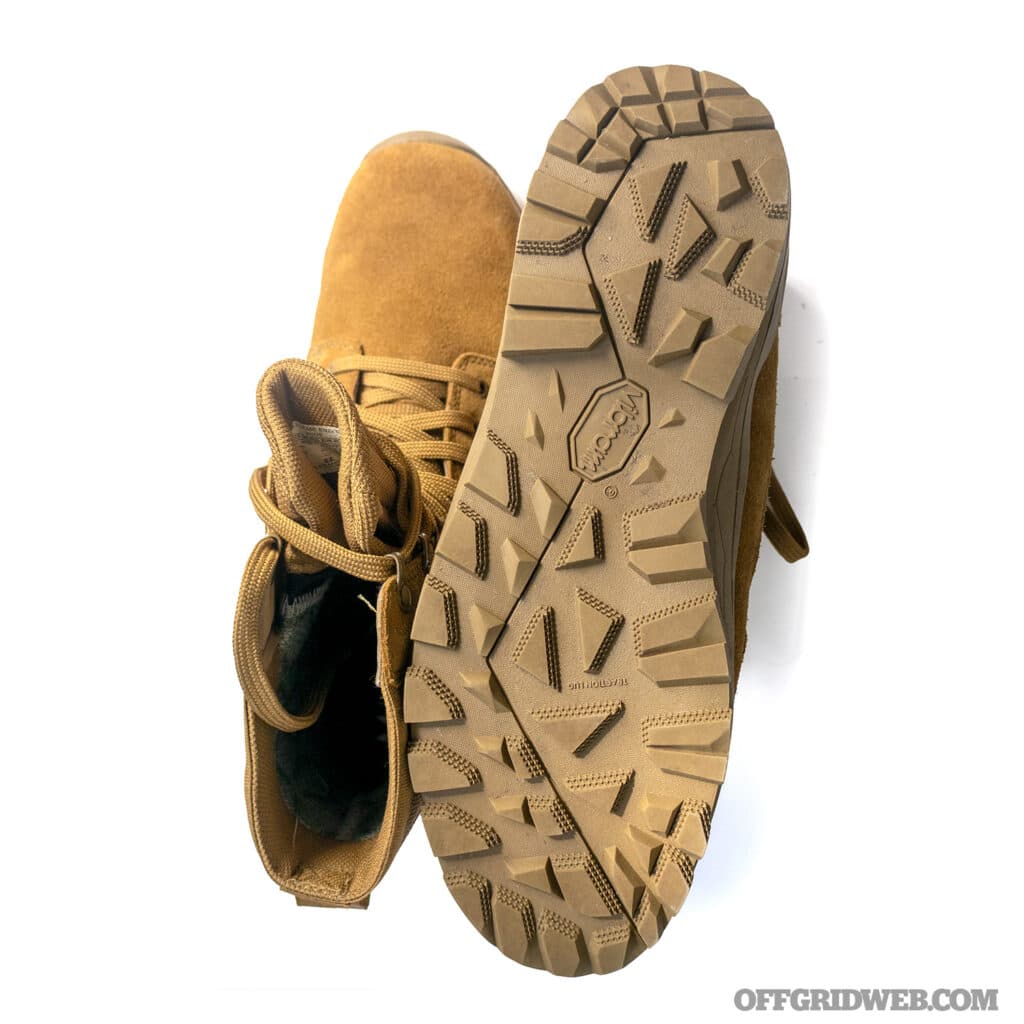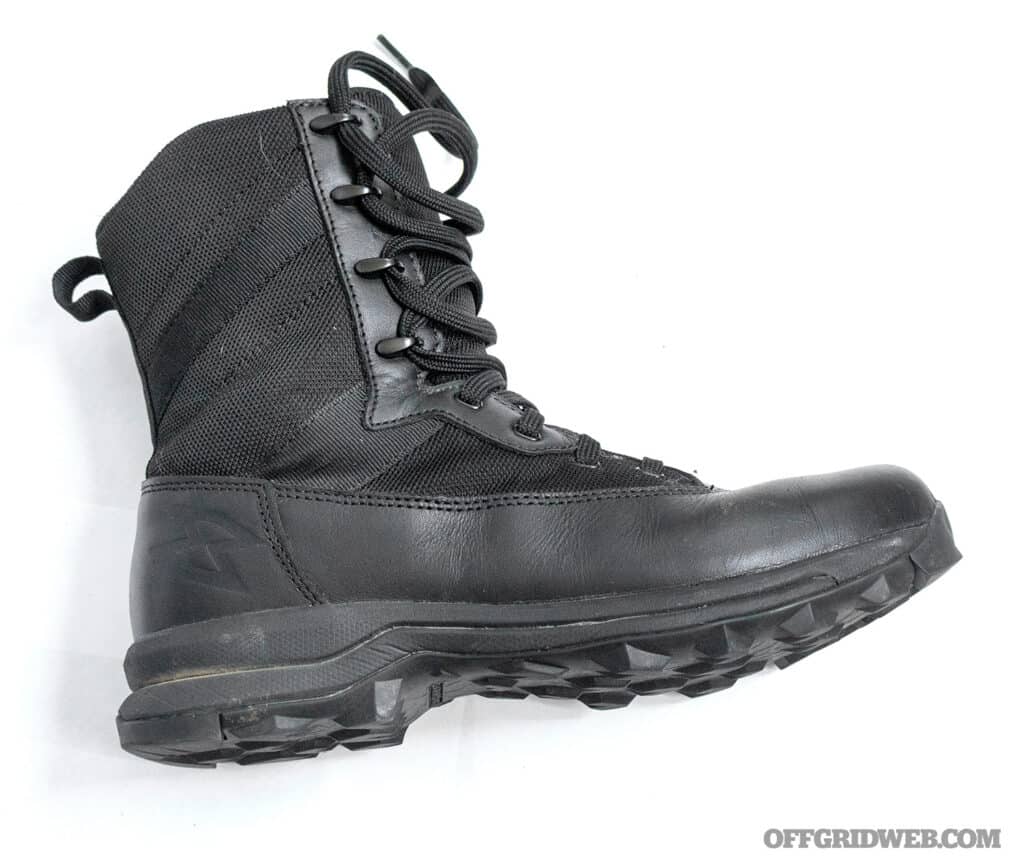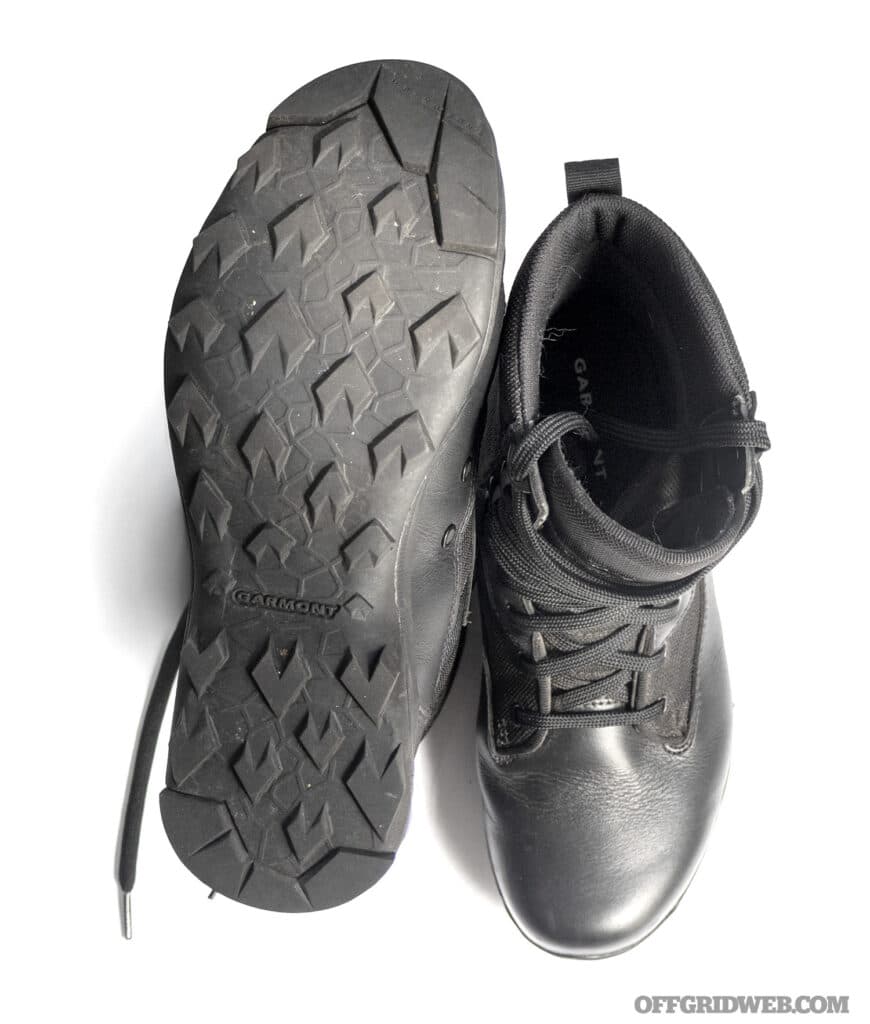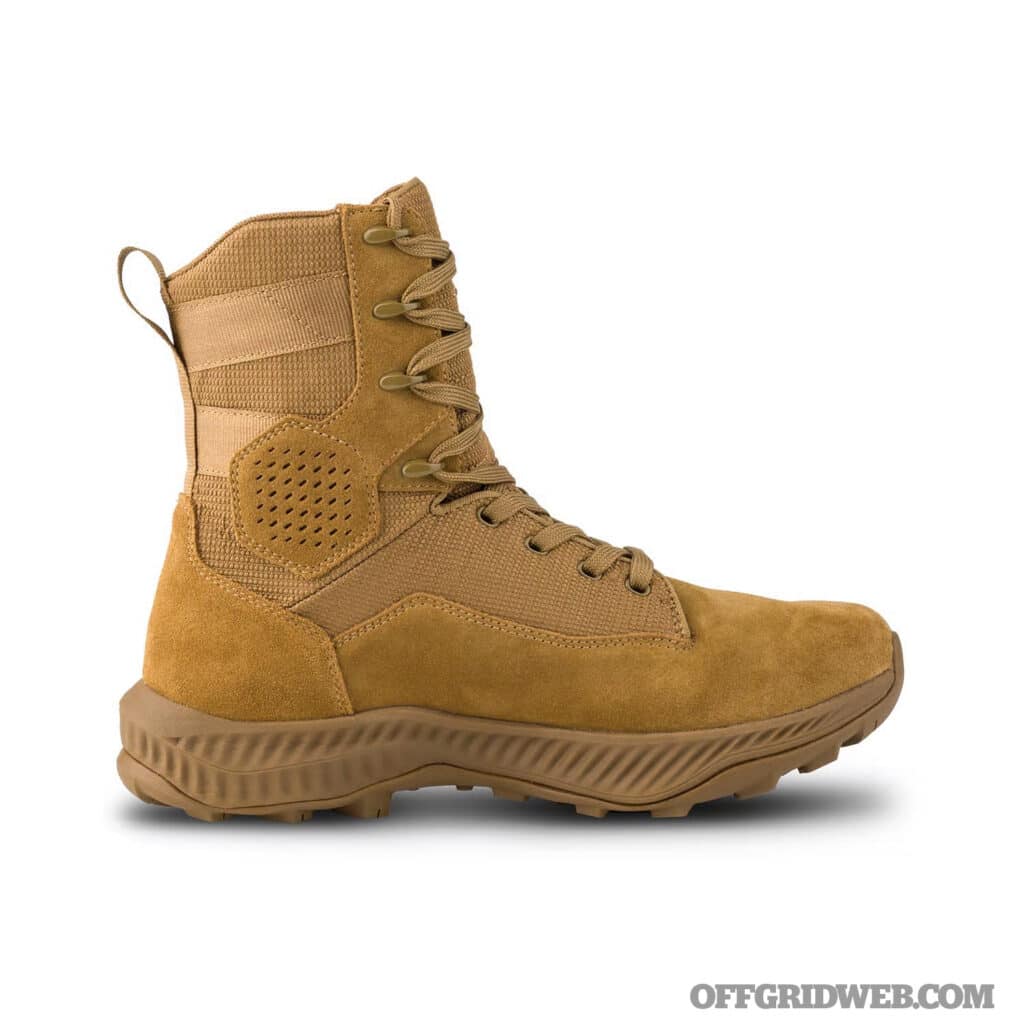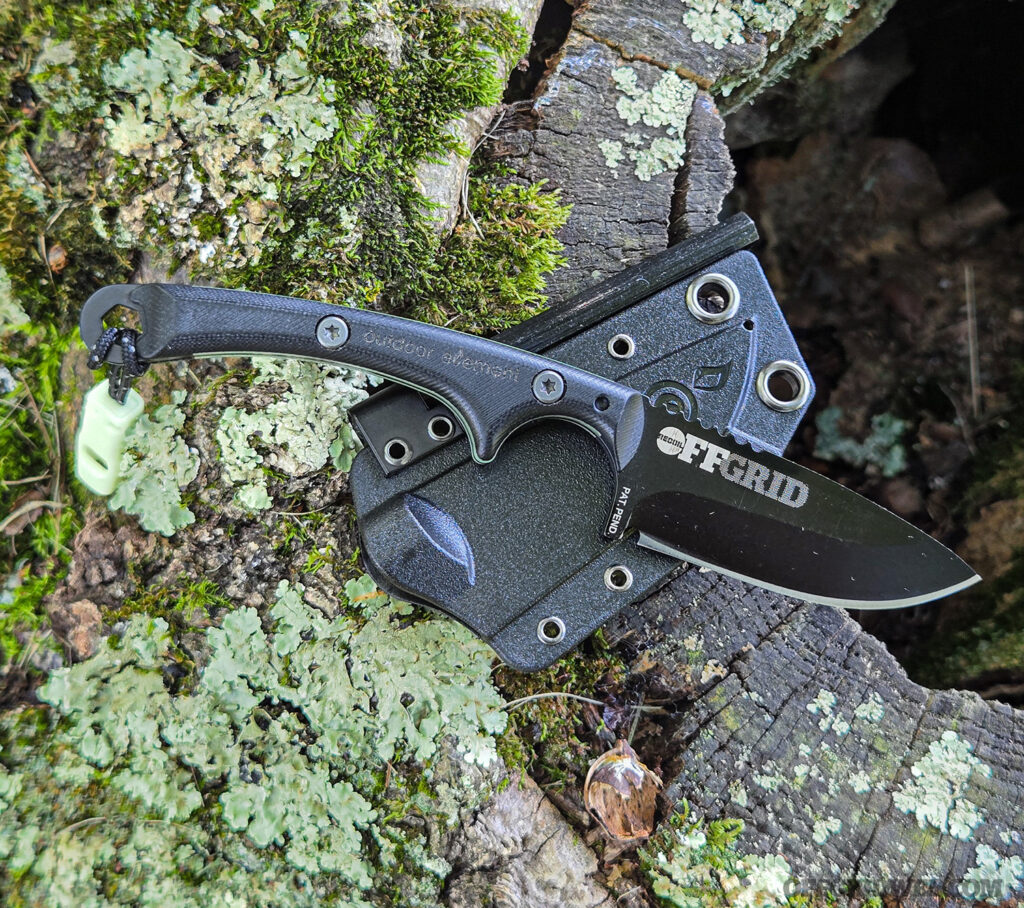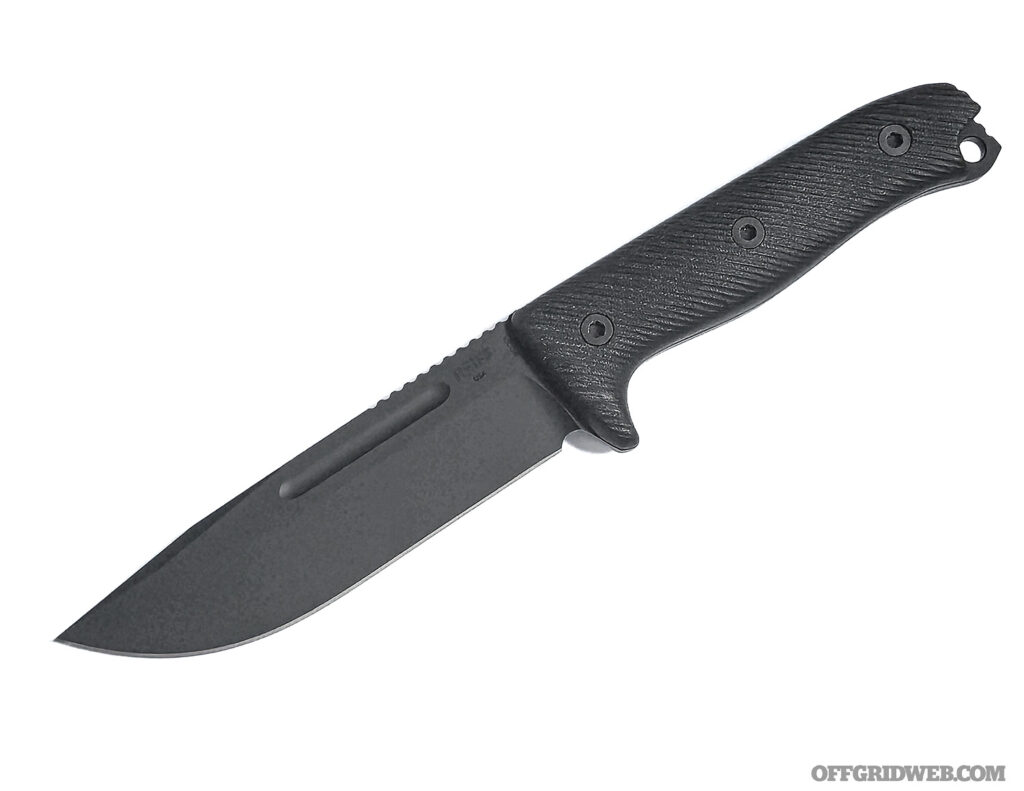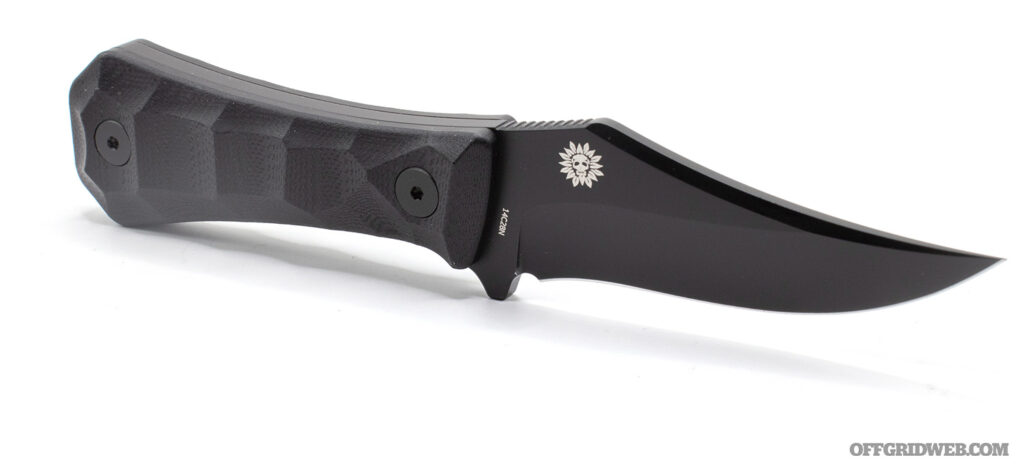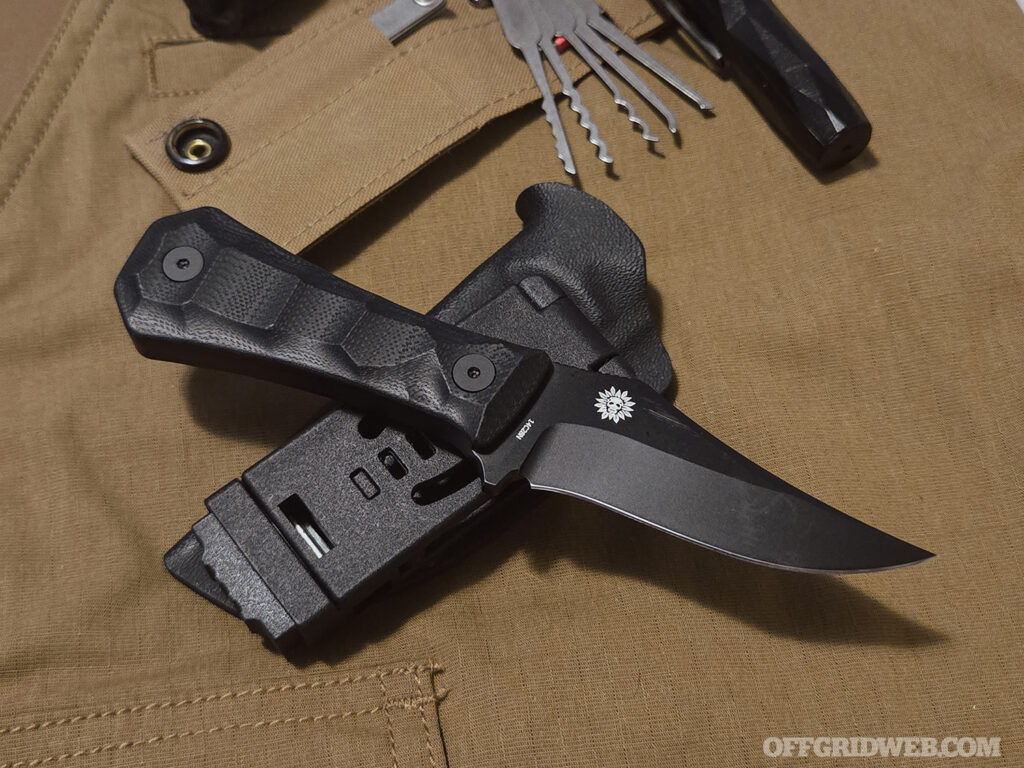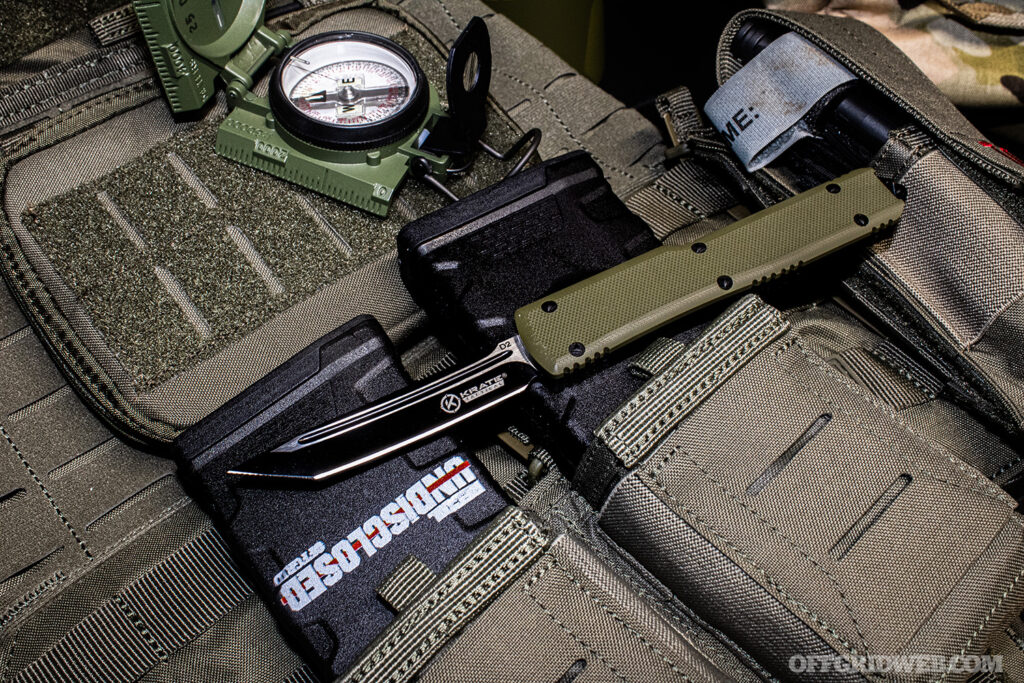In This Article
The participants who signed up for RECOIL OFFGRID Undisclosed knew very little about what they were getting into. They knew that they were signing up to be part of an immersive tactical training event that would last approximately 36 hours somewhere in the vicinity of Pittsburgh, Pennsylvania — and they knew that we had selected some of the best instructors in their respective fields to train them.
On arrival, Undisclosed VIPs hit the Lodge, got the mission brief, split into teams, geared up, and prepped for what was coming next. The night set off with a trauma care overview, a primer for the training to follow. The evening was spent getting to know one another, the instructors, and the support crew over good food and easy conversation. Still, unease lingered. Details of what was coming remained vague. None of the VIPs realized this would be their last chance to relax for the next 30 hours.
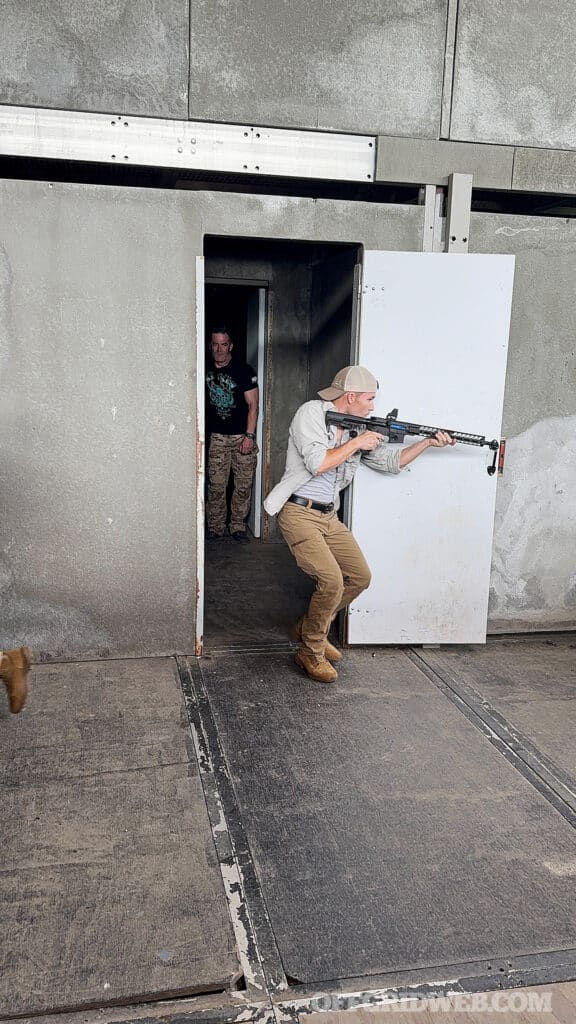
Each block of instruction was approximately an hour long. This meant they had to pick up the fundamentals quickly and apply them immediately.
Drinking from a Fire Hose
Training day kicked off at 7 a.m. with a quick grab-and-go breakfast. After a bite to eat, the participants were told to gear up in their full kit, and the group rucked down to the Ben Franklin Range shoot house. From there, the two groups split up for a marathon of training that went from 8 a.m. to 5 p.m. with only a short break for an authentic MRE lunch.
Over the course of nine hours, the participants covered several vital tactical and survival topics and learned to utilize the gear they received the day before. Each class offered the opportunity to get some practice time for each skill. Following the completion of the day’s classes, the weary participants returned to the lodge for dinner and were encouraged to ask the instructors to clarify anything they learned that they didn’t fully grasp.
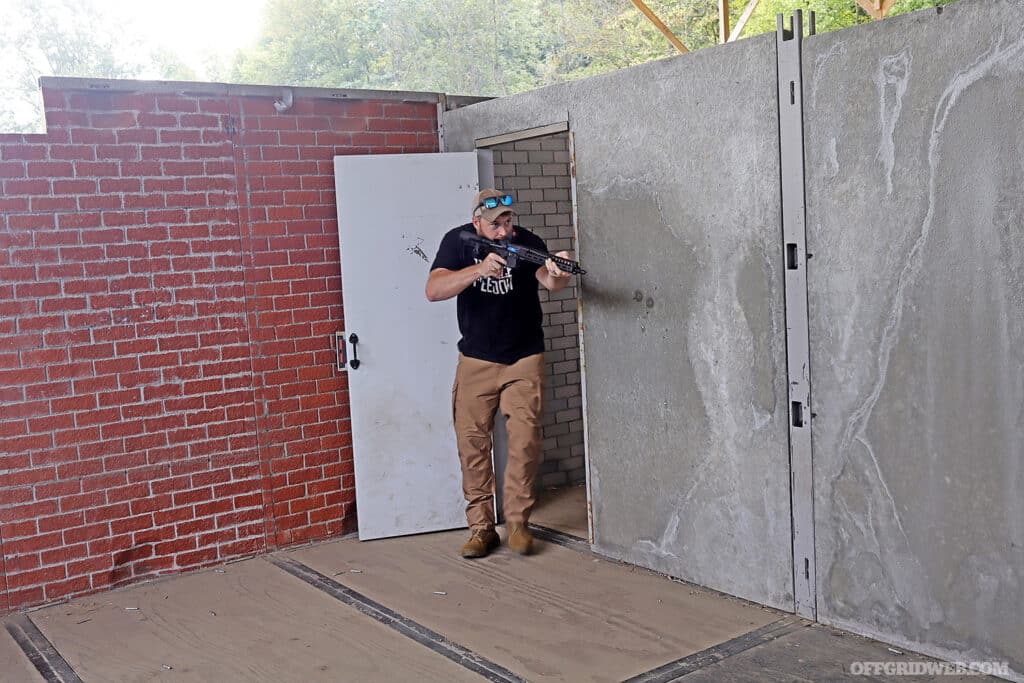
Reacting to this breakneck pace mimicked the velocity a real-world situation can force on an individual. It was a controlled environment where VIPs could learn how to control themelves in potential do-or-die scenarios.
Close Quarters Combat
At Ben Franklin Range’s multi-story CQB building, RECOIL’s Editor-in-Chief Iain Harrison taught an introduction to close quarters combat for Undisclosed VIPs. The class set clear expectations from the start and stayed focused on fundamentals. The goal was a fast primer that put movement before theory. Every block designed to be simple, repeatable, and immediately useful.
Participants worked in four-person teams throughout the session. Harrison defined what each position in the stack was responsible for during an entry. Teams hear how duties shift based on who is the one-, two-, three-, or four-man in the stack. That shared understanding framed every rep that followed.
Teams began by pieing corners around corner-fed and center-fed rooms. They practiced reading angles and adjusting movement to match their place in the order. Reps stayed tight and controlled to reinforce clean footwork and spacing. The emphasis was on exposing as little of yourself as possible, while maximizing your own visibility of potential targets.
After a few runs with no rounds, teams cleared rooms with simunition. The switch kept the same fundamentals in place while adding training speed. Entries remained structured around position and room type. The class ended with concise takeaways that align with the drills they just performed.
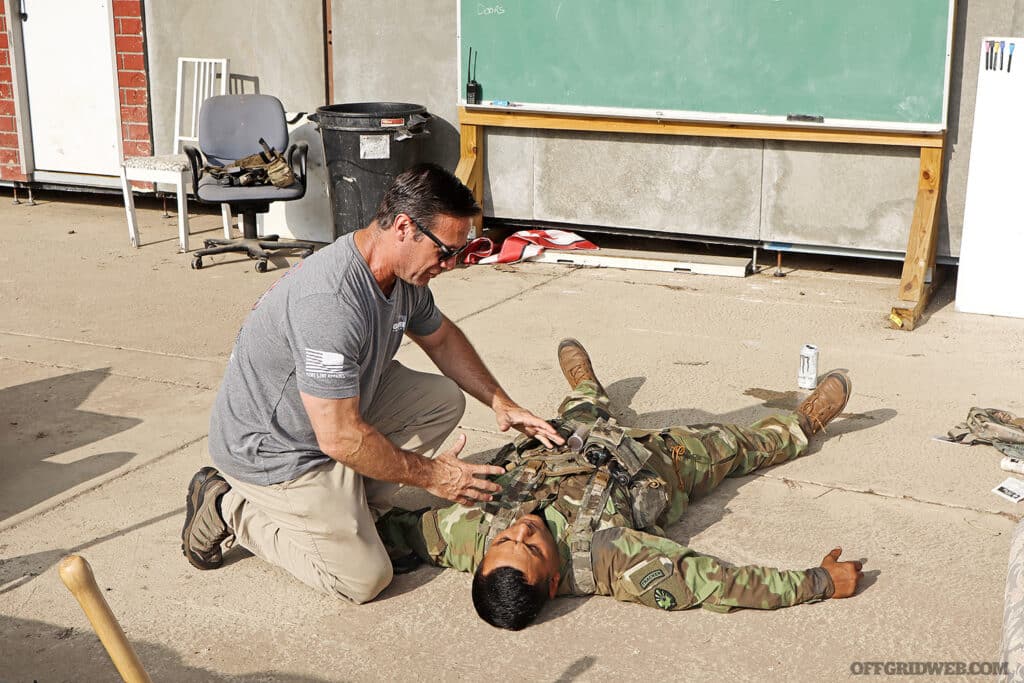
Injury treatment was explained in simple ways, reducing the time spent thinking, and increasing the time spent acting.
Ballistic Trauma Care
Kristopher Hasenauer used his extensive experience as a Special Forces Medical Officer to train the Undisclosed participants in the essentials of ballistic and battlefield emergency care. This course covered common firearm and combat-related injuries and the equipment and techniques used to treat these injuries.
Hasenauer discussed prioritizing injury types using the Tactical Combat Casualty Care (TCCC) and how to utilize the head-to-toe method for identifying injuries.
TCCC Injury Priority:
- Massive Bleeds
- Airway
- Respiration
- Circulation
- Hypothermia
- Traumatic Brain Injury
As a crash course, Hasenauer focused on treating massive bleeds, discussing the science of blood clotting, the importance of applying pressure to wounds, and the appropriate situations to use tourniquets, quick clots, pressure bandages, and gauze. He demonstrated how to use different types of tourniquets and how to create improvised tourniquets.
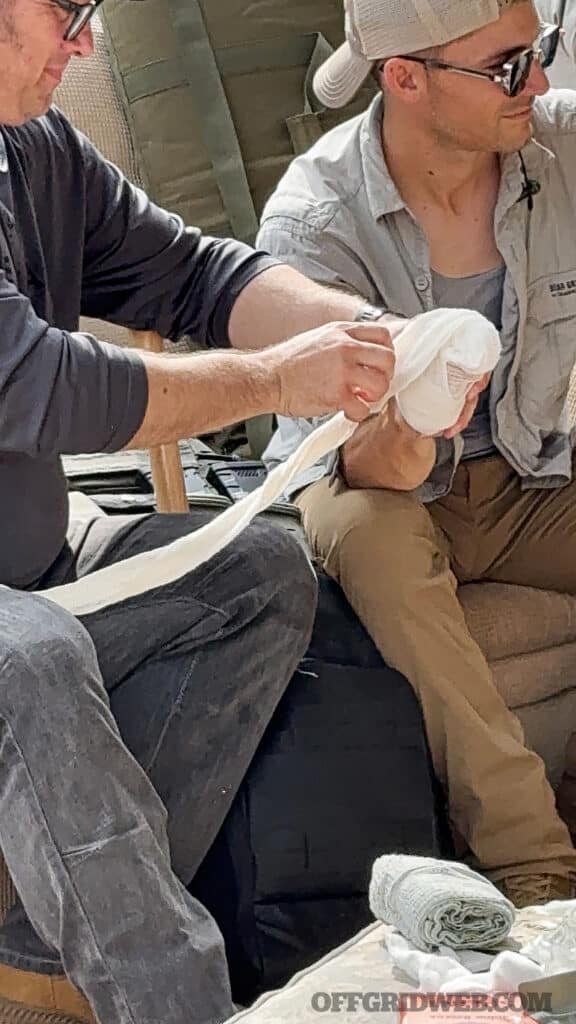
Having a selection of the most effective medical equipment to treat traumatic injuries gave VIPs practical, hands-on experience.
Most importantly, he dispelled many of the myths around tourniquet use and reminded the participants that the best tourniquet is the one you have on you. The participants all experienced having a tourniquet put on them so they could understand the proper tension and got the opportunity to practice using them.
Following massive bleed treatment, Hasenauer covered treating airway and respiration discussing methods of clearing the airway and discussing the use of commercial chest seals, how to make improvised chest seals, and needle decompression to treat tension pneumothorax.
Some time was spent discussing circulation injuries, hypothermia prevention, and identifying traumatic brain injuries followed by treatment of non-life-threatening injuries and the usage of common first aid equipment including splints for arm and leg injuries.
Throughout the course, Hasenauer discussed the differences between military and civilian trauma and first aid and answered many of the questions the Undisclosed participants had. While the course run time was relatively short compared to the extensive training programs, the participants left with a great deal of knowledge and a basic understanding of how to utilize the equipment found in their supplied Gorilla Medical Trauma kits.

CQB can be a useful skill, but it also presents a high amount of risk. Learning how to reach out and touch someone puts life-saving distance between you and a life-threatening target.
Long-Range Shooting
Harrison also plied his marksmanship expertise to teach an introduction to long-range marksmanship for Undisclosed VIPs. The class set expectations early and stayed on fundamentals. The goal was a fast primer that built a repeatable shot process. Each block was simple, focused, and immediately useful.
He broke the shot sequence into clear parts. Students built a stable position they could return to every time. Instruction covered natural point of aim, sight picture, trigger control, and follow-through. Shared language kept everyone aligned on the same steps.
Work began with short dry-fire reps to groove the routine. Dry practice set the cadence for breathing, prep, and release. Coached strings followed to put the same steps into practice. Students focused on calling shots and making small adjustments between reps.
The session closed by sending rounds downrange to transform theory into live range time. Students left with a concise set of reminders that mirrored the sequence taught. Emphasis stayed on repeatability and clean fundamentals. Fifty minutes of clear instruction and focused reps set a solid foundation for longer work.
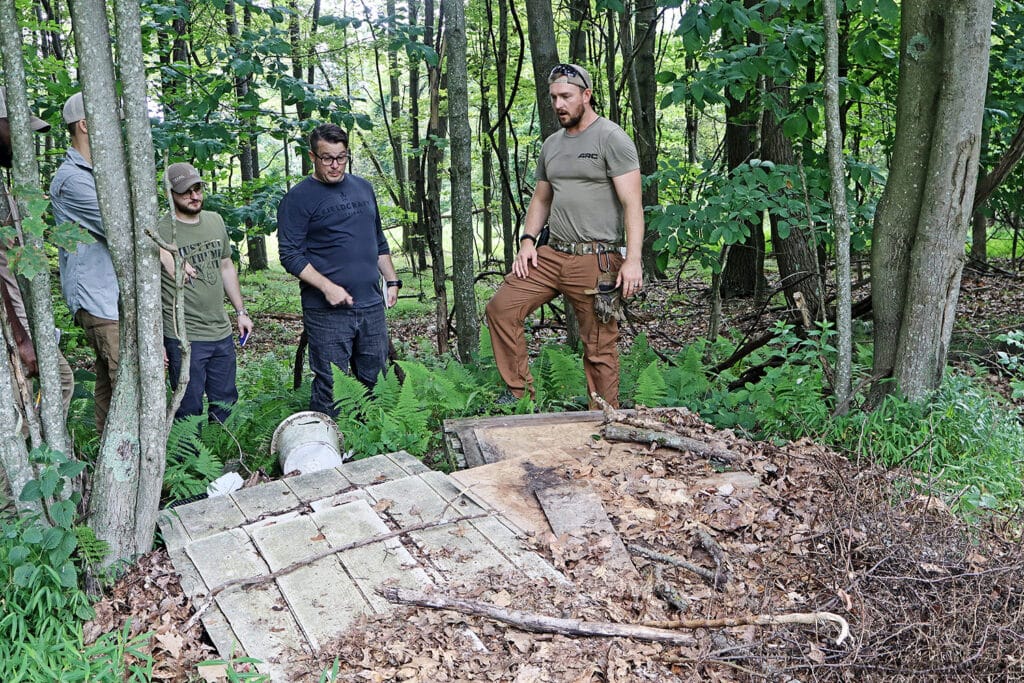
Navigating an area alive with threats takes deliberate planning to stay unseen.
RECOIL OFFGRID Senior Editor Patrick Diedrich taught a land navigation course that did not rely on a map or a compass. He opened with a story about a failed missing person’s case from a place he once called home. That moment became his call to action to apply his military know-how to help his local search-and-rescue organization. He set the tone by tying skills to real outcomes. The aim was clear and practical from the first minute.
He then covered major and minor terrain features. He explained how identifying those features could help others home in on your location if you were lost. The same skill set could orient you and shorten the path to safety. He kept the focus on what you can see and describe. Students learned to use the ground as their guide.
He also taught how to use the OnX app, since everyone has a phone that can be used as a potent navigation tool. He discussed key points from Lost Person Behavior that affect how people move and how they are found. He outlined methods to hold a straight line when the sun was covered or when visibility was low. The guidance stayed simple and usable under stress. Each point supported navigation without extra tools.
The session culminated in a practical exercise around the Ben Franklin Range. Undisclosed VIPs applied the same techniques discussed in class to move from point to point. The route demanded attention to terrain and consistent direction keeping. The drill reinforced the connection between observation and movement. Students finished with a working framework they could repeat on their own.
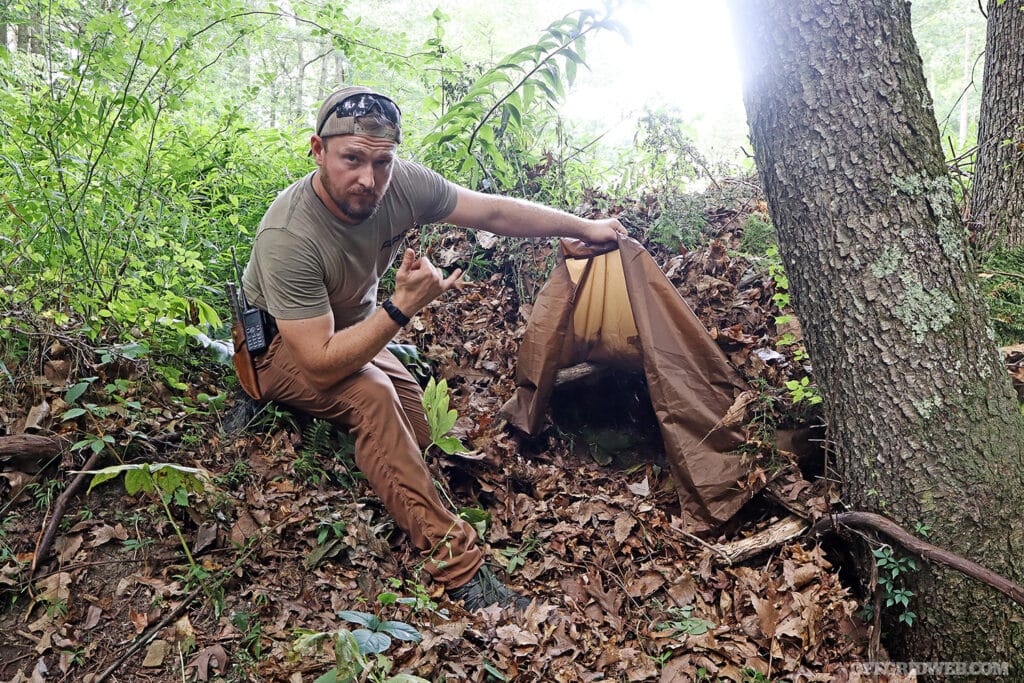
The best clandestine shelter does not look like a shelter at all to the casual observer.
Escape and Evasion
In the escape and evasion course, Michael Caughran covered the basics of defeating illegal restraints and how to evade hostile forces when making your escape from an area both individually and as a group.
The course opened with Caughran discussing a variety of restraint types that are commonly used including zip ties, rope, duct tape, and electrical tape. With the help of Hasenauer, who used these methods to restrain Caughran, methods of defeating each were shown to the Undisclosed participants. Through the demonstration, Caughran discussed using passive resistance and proper body position while being retrained to provide an advantage when defeating the restraints.
Caughran explained that the more aggressive you are when being restrained the more the abductor would work to restrain you. By remaining calm and compliant, it can lull the abductor into a false sense of security when retraining and guarding you. While remaining compliant you should take note of any information you can gather such as building layout, people within the area and their movements to provide an edge when escaping. Caughran emphasized that the best chance of escape will be shortly after you are taken as you will not be worn down from poor conditions and potential integration.
Following the demonstration and discussion, the participants got the opportunity to practice defeating each of the restraint types before moving on to the escape portion of the evasion part of the course.
During the evasion portion of the course, the participants had to escape from the lodge area into the woodland trails behind the building. Caughran emphasized the importance of “getting off the X” as quickly as possible and putting as much distance between the escape point as possible. During this portion, the participants were taught to move quickly as a unit and how to use terrain features to cover their movement. Caughran and Hasenauer covered the best times to move, avoiding areas where patrols are likely, and generally avoiding the easy route in favor of areas that are less likely to have hostiles moving about.
The course is wrapped up with a discussion about the importance of pre-planning meeting points for your unit when operating in an area in the event of separation. This is contingent on having a good knowledge of the lay of the land before entering the area.
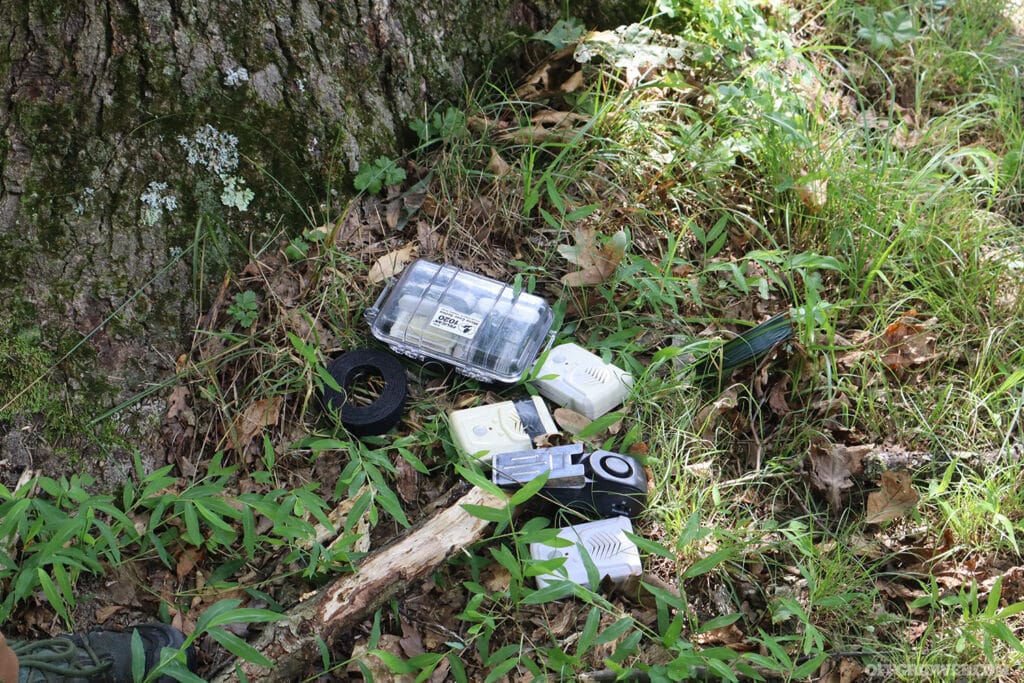
Early warning is an important aspect of maintaining security at a clandestine shelter site. Caughran discussed several techniques that could be used.
Clandestine Shelters
Caughran’s course covered building a variety of survival shelters using the participants supplied Rab tarps and paracord. While this skill is commonly taught in Wilderness Survival 101, Caughran kicks it up a notch using his USAF SERE experience to teach the Undisclosed participants how to build effective concealment shelters from the resources around them.
The class kicked off with a discussion of some of the concepts around concealment shelters and their use to evade those tracking you and to gather information on an area or building. In the case of evasion, Caughran emphasized the importance of understanding the tracking capabilities of those pursuing you. He discussed methods of ensuring that enemy forces cannot see you while remaining visible to friendly forces.
After the discussion, Caughran took the participants around the training site to attempt to identify shelters he had built the previous day. He also strategically placed distraction devices in the area to throw the participants off. After explaining the uses of distraction devices, Caughran revealed his shelters. The first looked like nothing more than a pile of discarded building materials but he demonstrated the interior space being large enough to fit his body and give him a great vantage point on the hypothetical target he was observing. The second concealment shelter Caughran created utilized natural plant materials found in the area. The only significant tell was that some of the day-old plant material he picked was starting to wither. Caughran reinforced the importance of using longer-lasting plant materials so as not give away your hide site. He also noted that the best concealment shelters are found not built.
Following the demonstration on concealed shelters, Caughran showed participants common devices that could be used as perimeter alarms, distractions, and deterrents to warn of incoming hostiles or throw them off track.
The course wrapped up with building a variety of tarp shelters and various knots and hitches that can be used while building non-concealment survival shelters. After that the participants had the opportunity to practice building shelters.
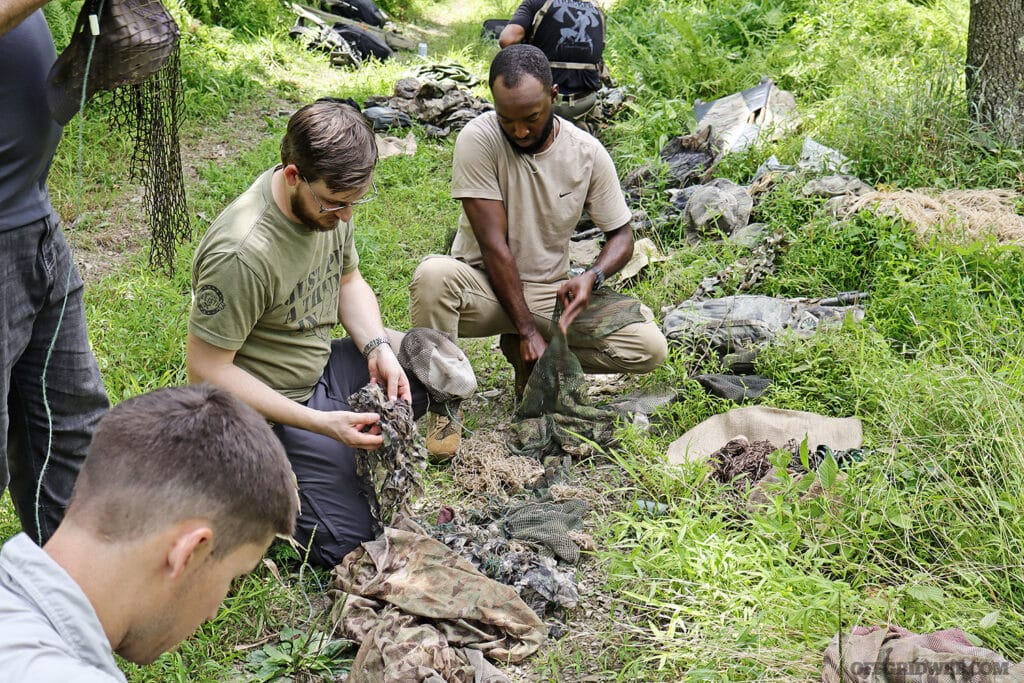
VIPs built their own ghillie veils, tweaking and adapting them as the environment shifted.
Camouflage and Sensory Defeat
In this course, Freddy Osuna covered the art and science of personal camouflage and discussed how to move silently and discreetly through the environment. This course blended Osuna’s professional experience as a Marine Scout Sniper and extensive knowledge of the environment to provide the Undisclosed participants with a unique approach to the topic.
The course started with the students following a trail behind the lodge to meet up with Osuna in a stretch of tall grassland in the woods. The participants found him The course started with the students following a trail behind the lodge to meet up with Osuna in a stretch of tall grassland in the woods. The participants found him waiting on a section of trail by a small tree housing an active wasp nest. As the participants glanced apprehensively at the nest, Osuna was completely unphased by them. He began the course with a brief discussion about the history of camouflage and then pulled out a collection of different types of camouflage to discuss the history and innovations throughout history.
The next section of the course went into the usage of camouflage paint on the body. Osuna explained different methods of applying camouflage paint with local plants as brush and stressed the importance of using it to reduce the visual appearance of facial structures. He also explained how the reflective nature of skin stresses constant reapplication of camouflage paint to maintain the effect.
Throughout the discussion, Osuna talked about the science of vision and how the human eye detects things. He went into the differences in how humans see and how animals see and why certain types of camouflage work on animals but not humans.
Next, Osuna covered movement through the environment and how erratic movement such as swatting at bugs around or on your body can quickly give away your position. He also discussed how the shape of the human “V” and contrast between the background and foreground are highly detectable to the human eye. Osuna demonstrated how to use local plants and terrain features to conceal yourself while moving.
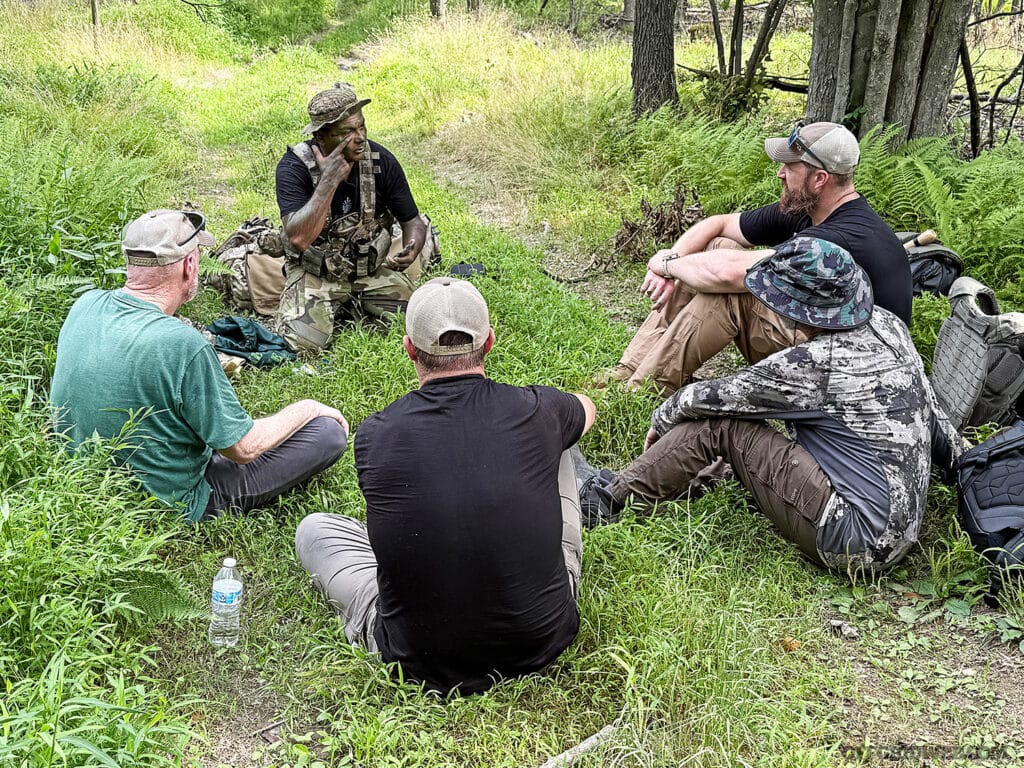
Participants learned multiple camouflage techniques, chose what worked best for them, and put those ideas to the test once the mission went live.
Osuna focused on the importance of understanding the environment around you and being familiar with the plants and animals within it. He explained how having a healthy respect for the land will allow you to survive longer and move more efficiently. To wrap this section, Osuna offered the participants the most valuable piece of advice when it comes to camouflaged movement: “It’s not what you are wearing; it’s how you move.”
The final section of the course covered creating ghillie suits using bits of camouflage material scraps and local plants. The participants were then tasked with creating their own ghillie veils using their provided hats, camo scraps, and natural materials.
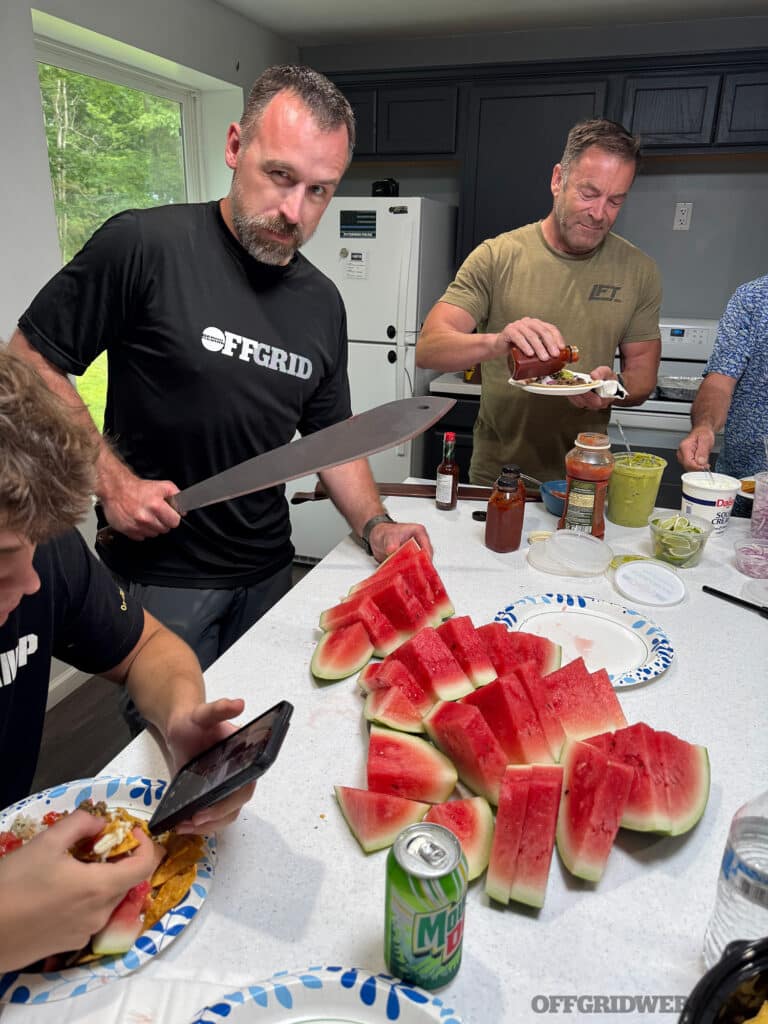
Breaks were short, but carried flashes of humor that kept spirits up.
A Short Reprieve
With the marathon of training classes ending around dusk, the weary participants shuffled into the lodge to eat dinner. They talked amongst themselves about the day’s events and discussed what their thoughts on tomorrow’s training may bring. They were given the opportunity to ask the instructors questions about the day’s training. It wasn’t long before the instructors and support staff discreetly started moving out of the room. Suddenly, the participants’ relaxation was interrupted by the sounds of shouting and gunfire in the distance. Diedrich went into the kitchen and called the participants into the briefing room for an emergency meeting — the official mission of Undisclosed was about to begin!
Read More From Issue 70
Don’t miss essential survival insights—sign up for Recoil Offgrid’s free newsletter today!
- Issue 70
- Challenge Facilitates Capability
- Between River and Sky: Recounting a Jungle Expedition
- Blades for any Challenge
- Garmont Tactical Boots
- Mission Ready Pack: Minimalist Survival Kit
- ATAC, OLIGHT & Sunshine
- GEAR UP: Mission Ready
- Grey Man Academy
- Into the Unknown at UNDISCLOSED
Check out our other publications on the web: Recoil | Gun Digest | Blade | RecoilTV | RECOILtv (YouTube)
Editor’s Note: This article has been modified from its original version for the web.


